
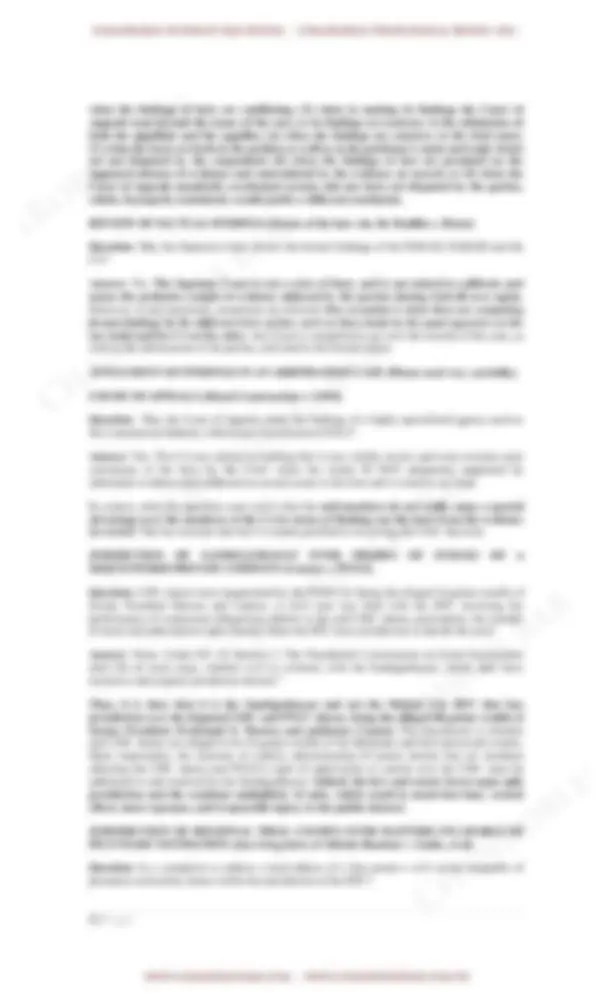
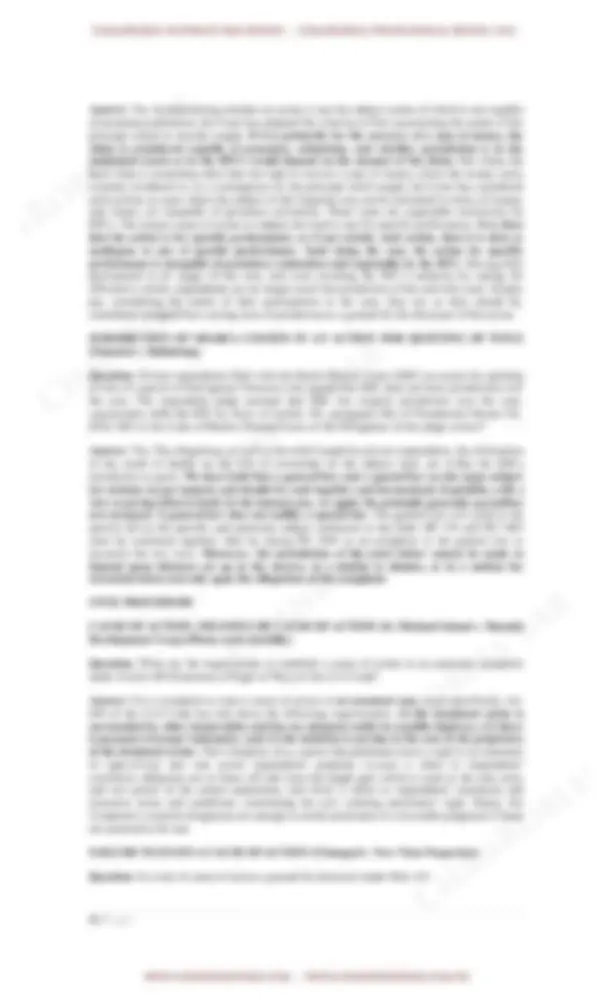
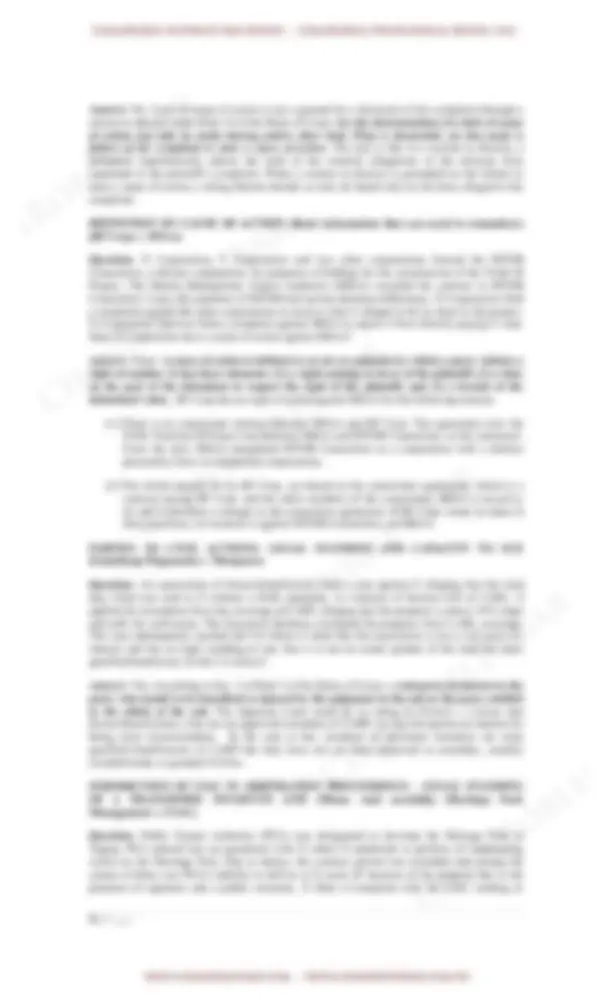
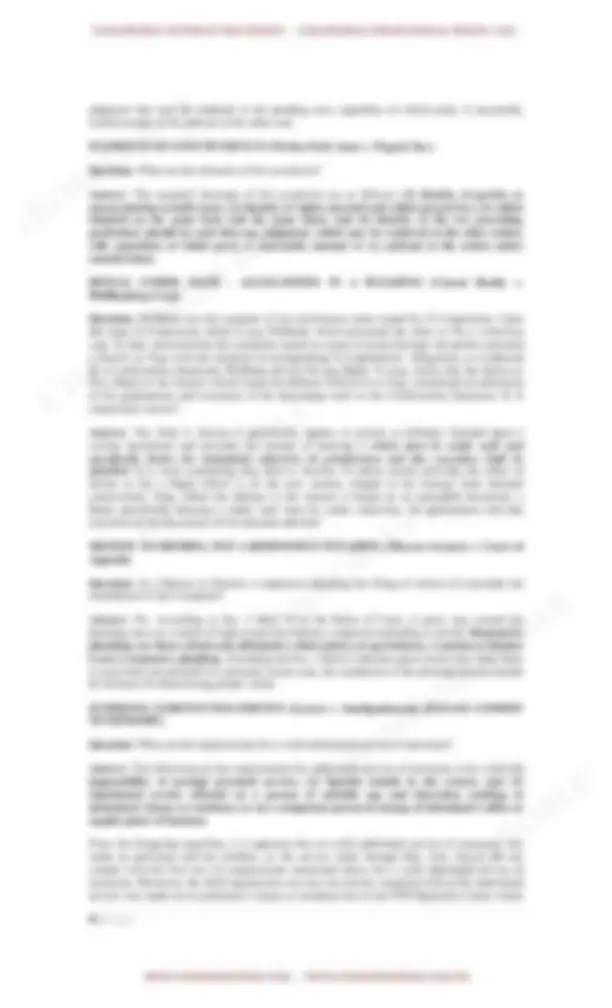
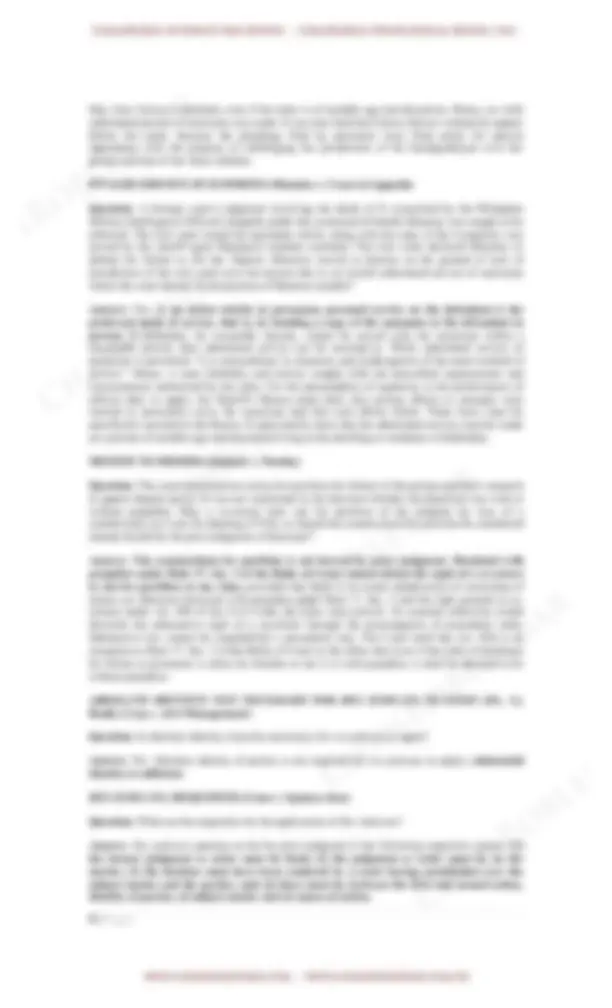
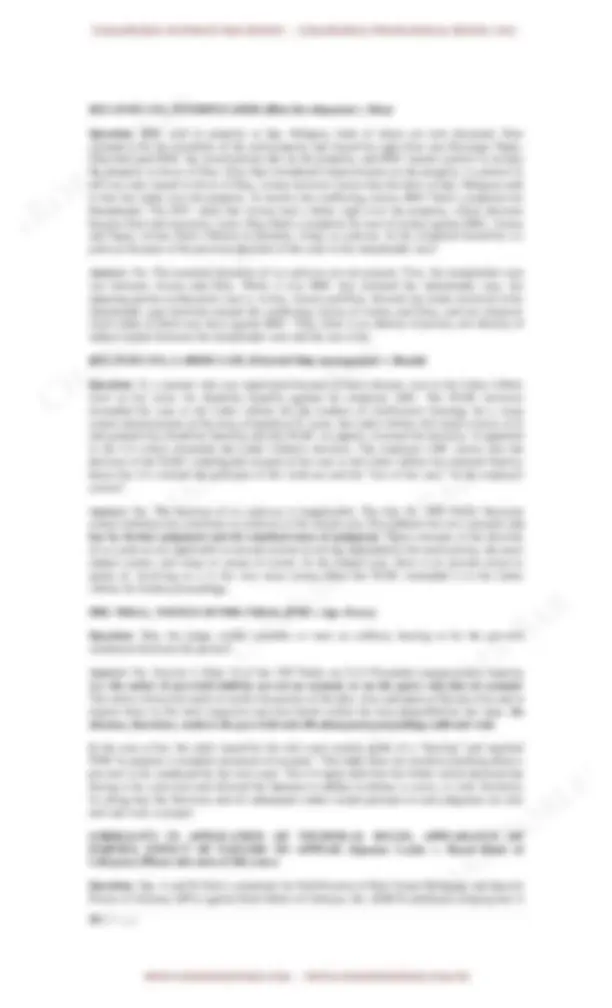
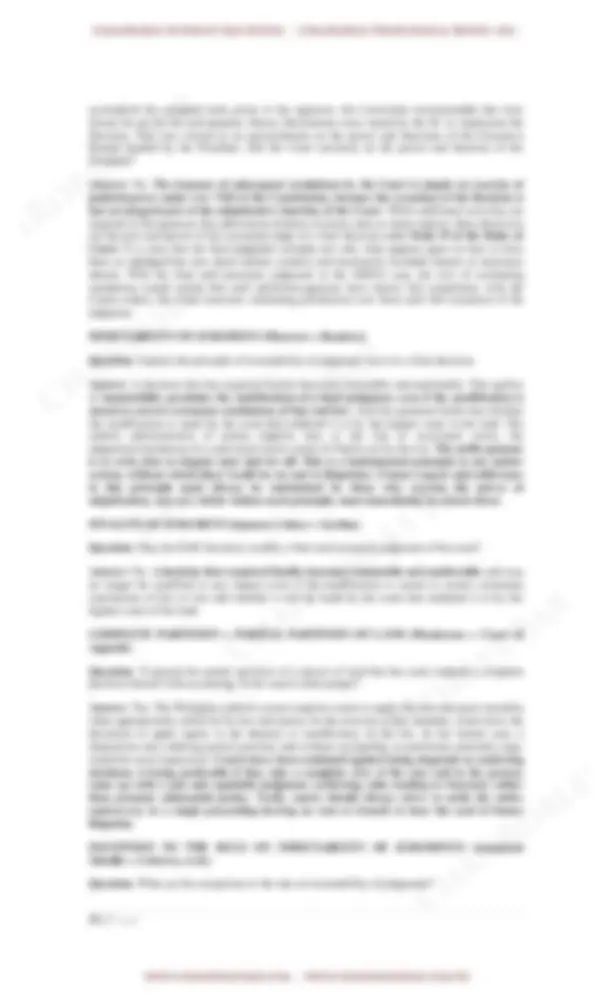

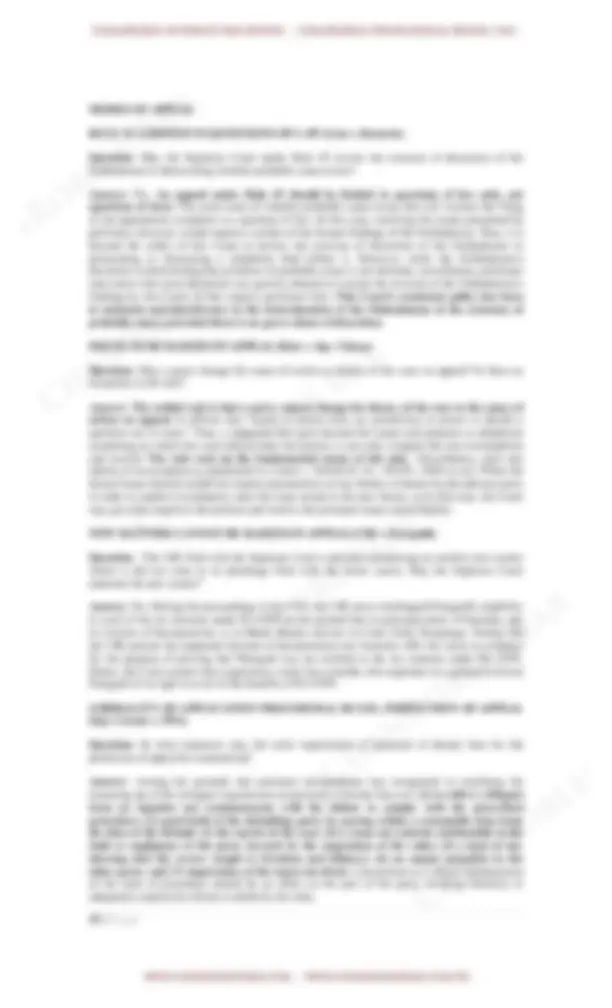
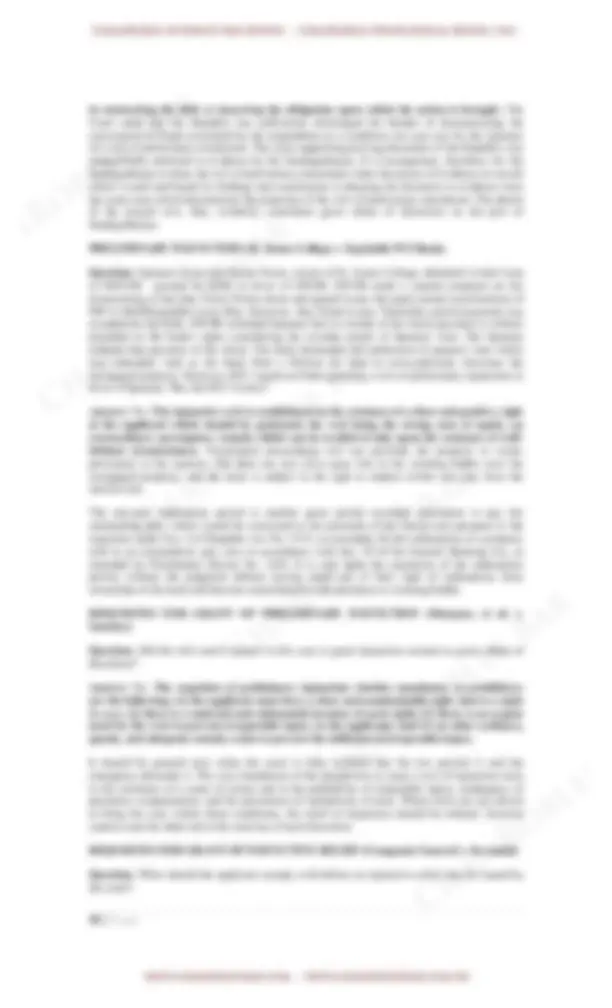
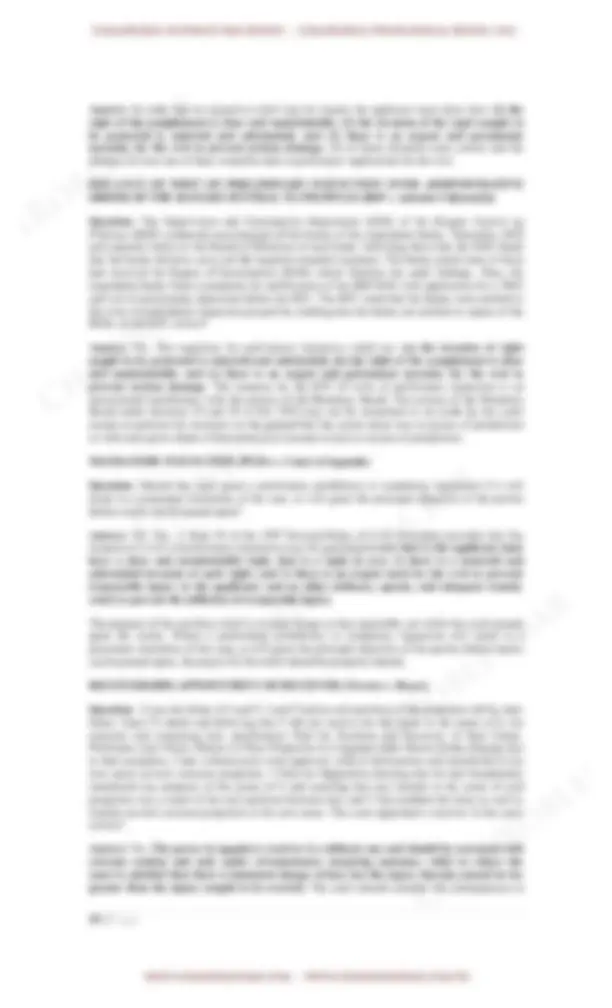
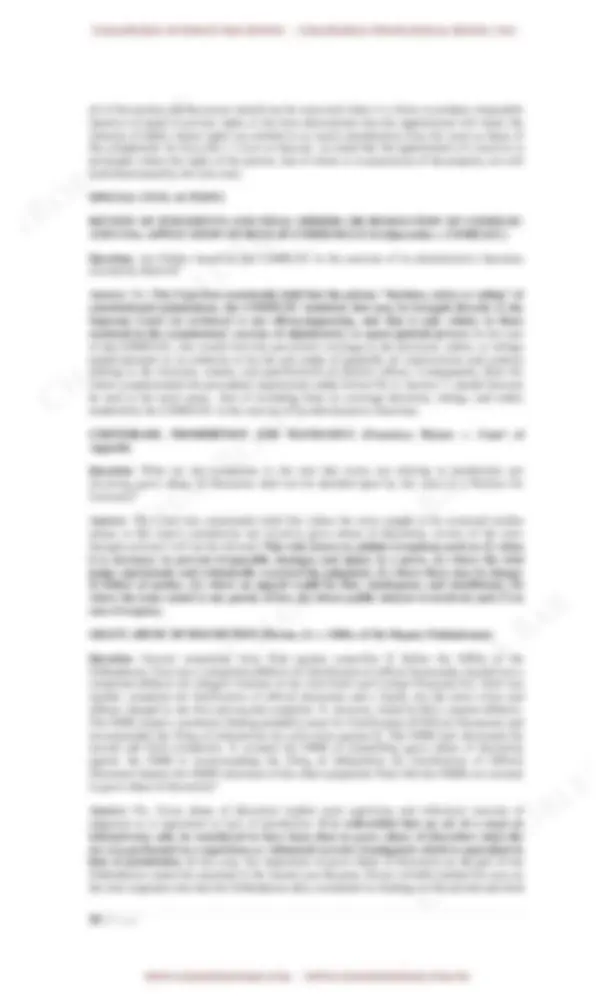
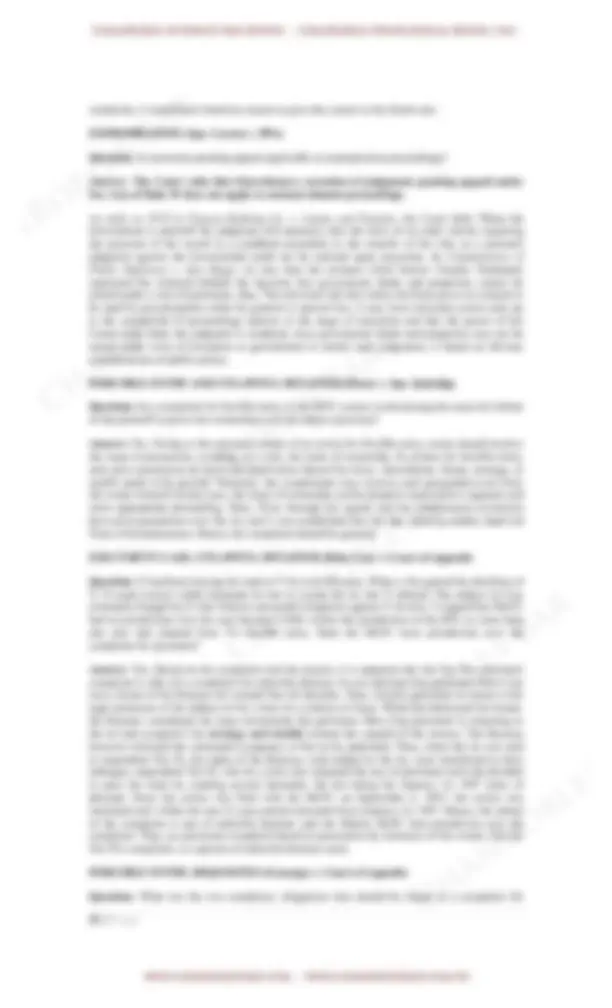
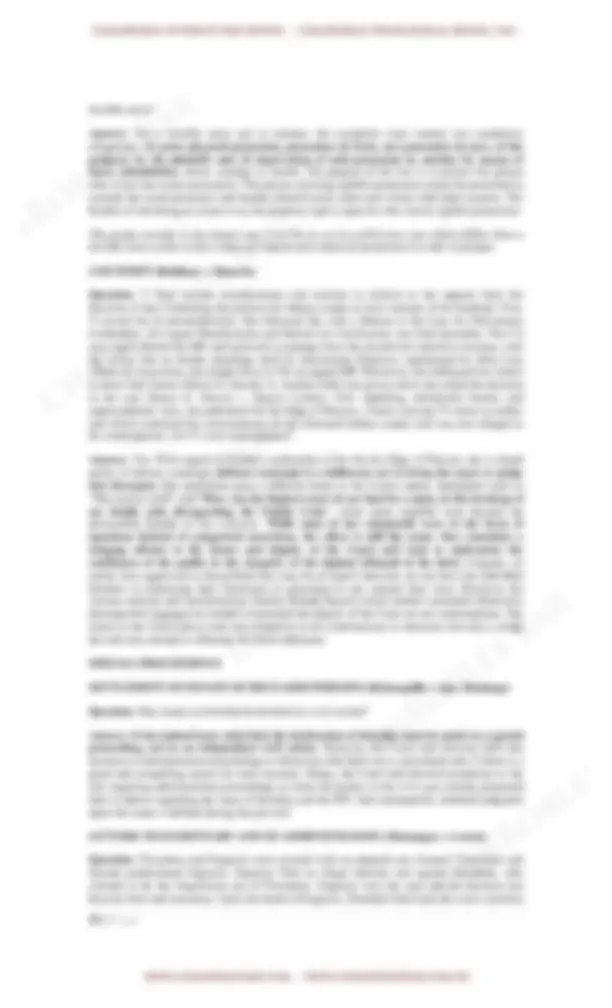
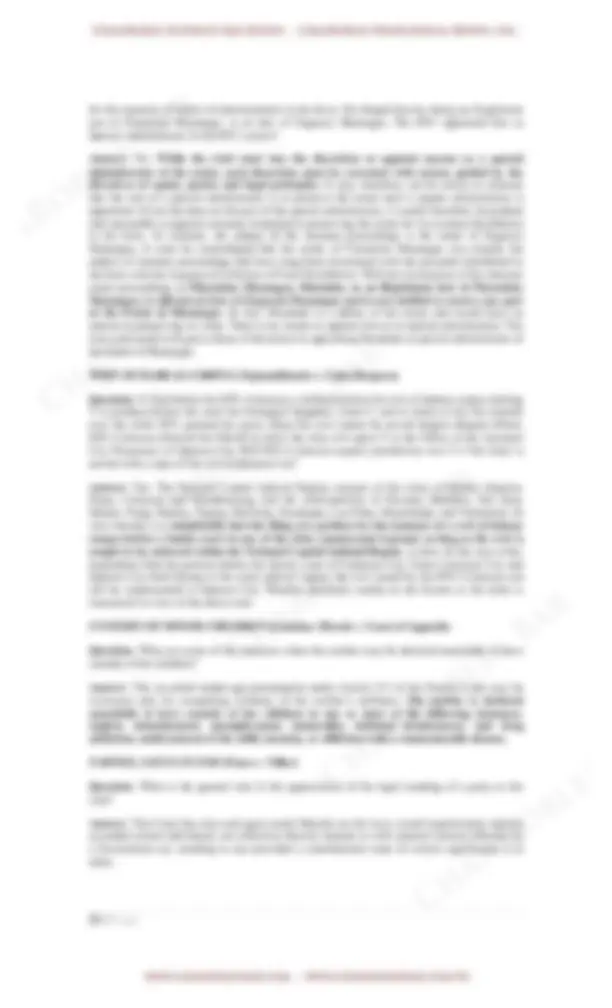


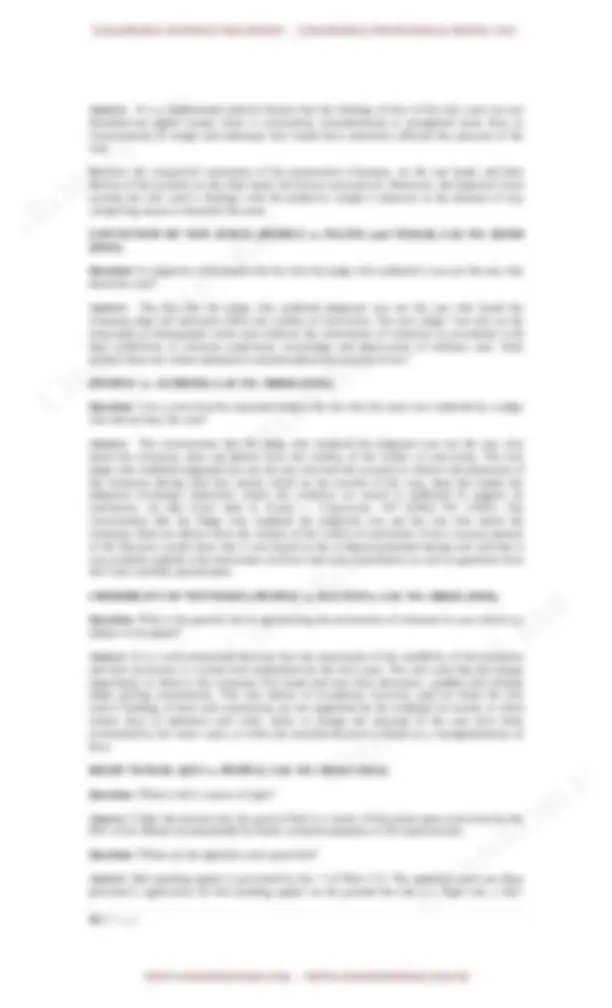

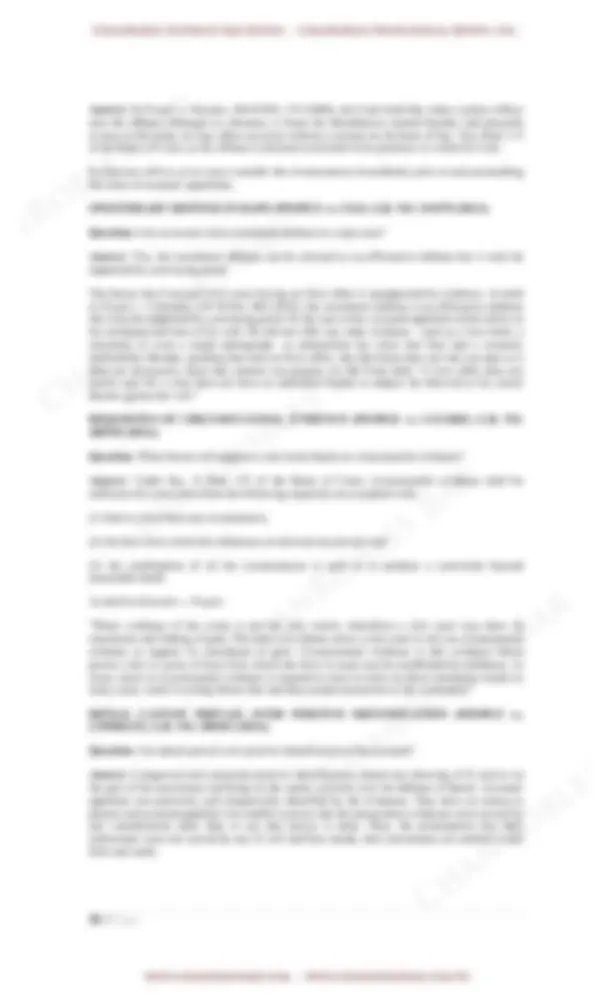
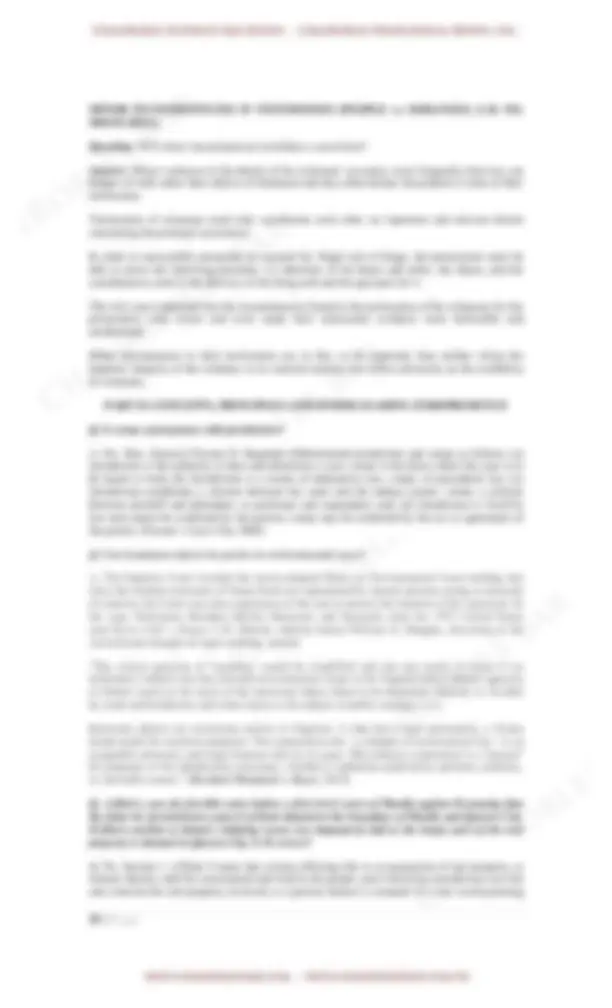
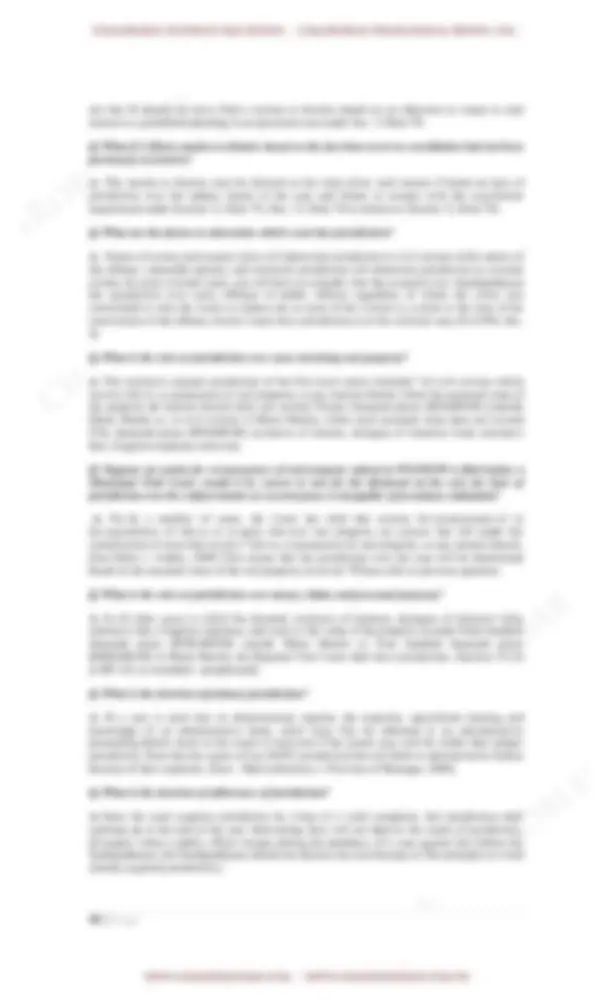

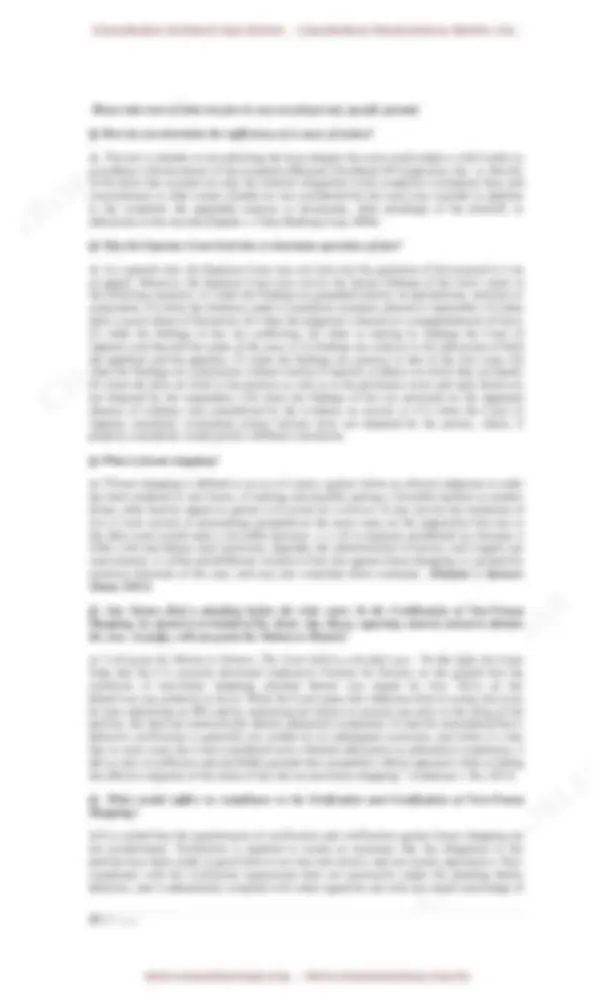
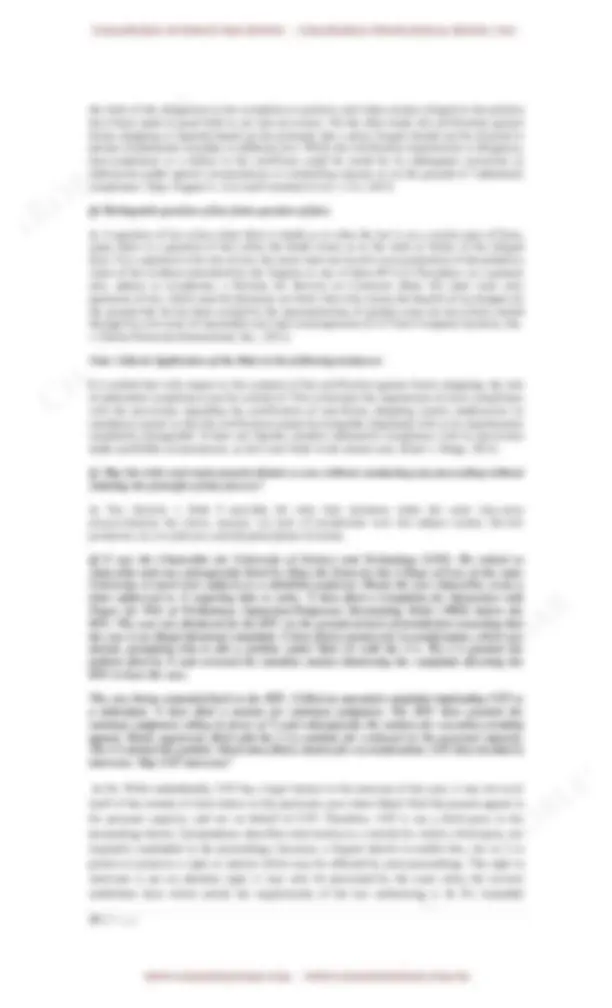
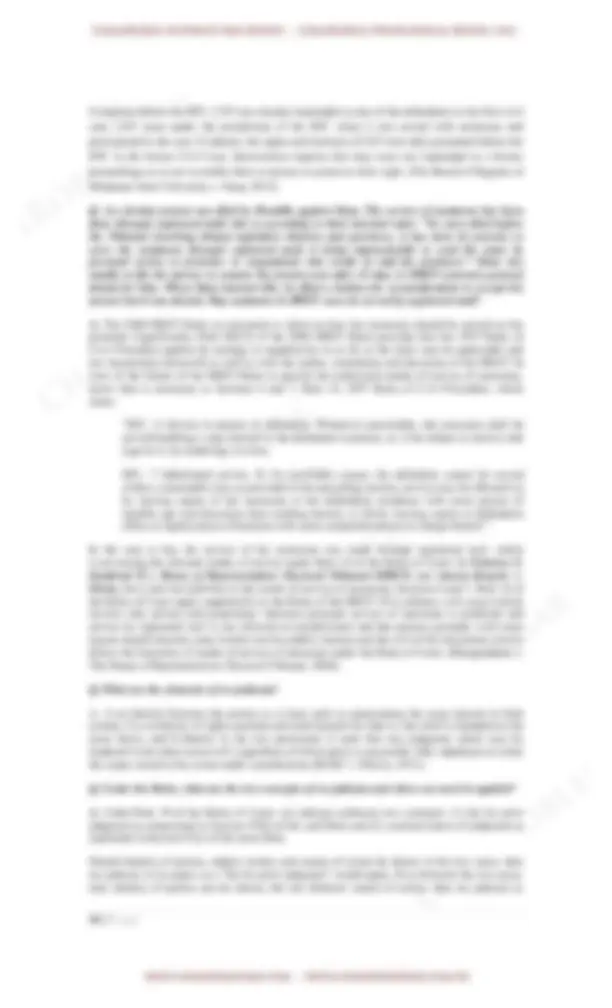
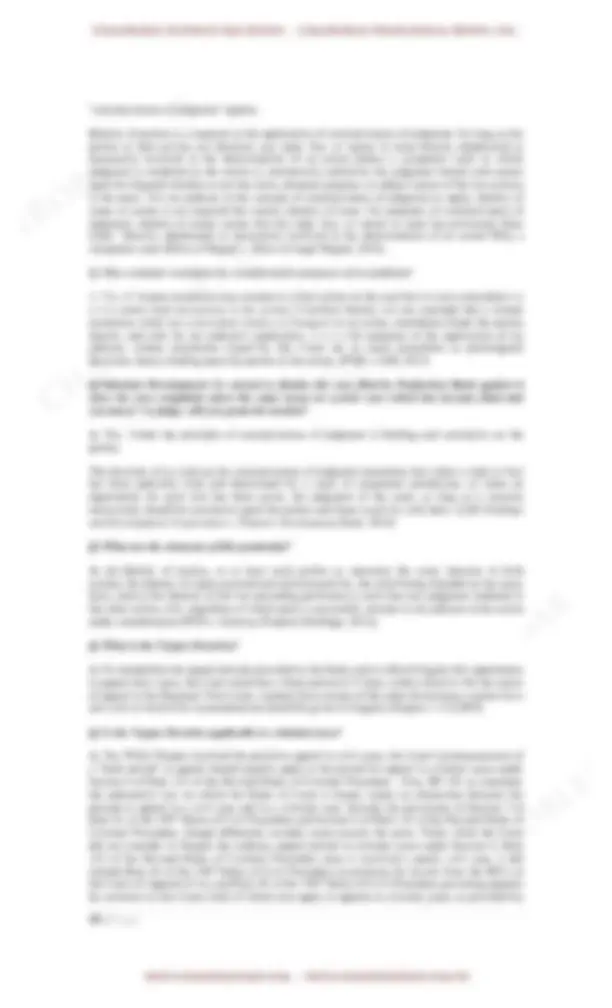
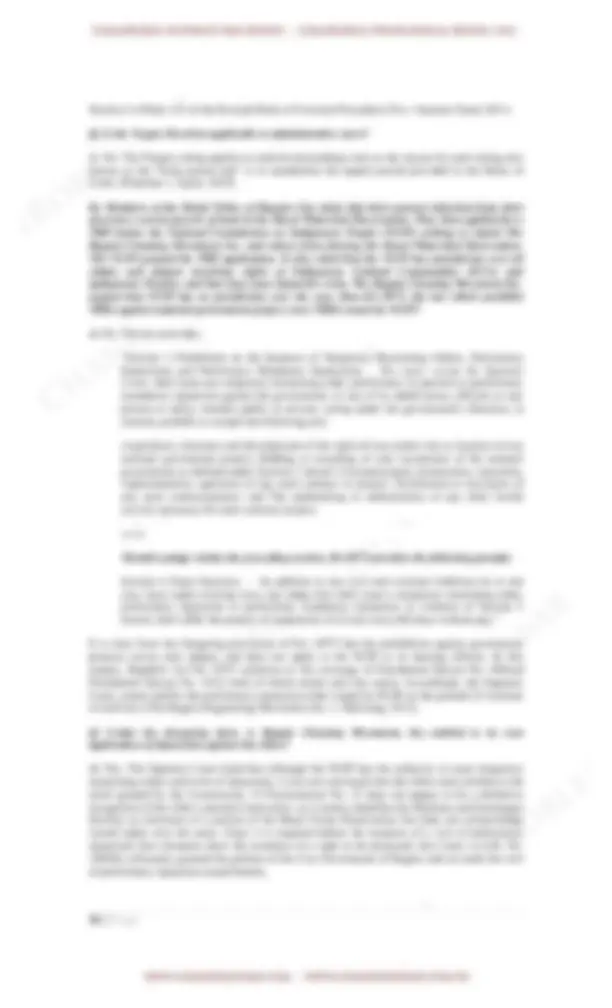
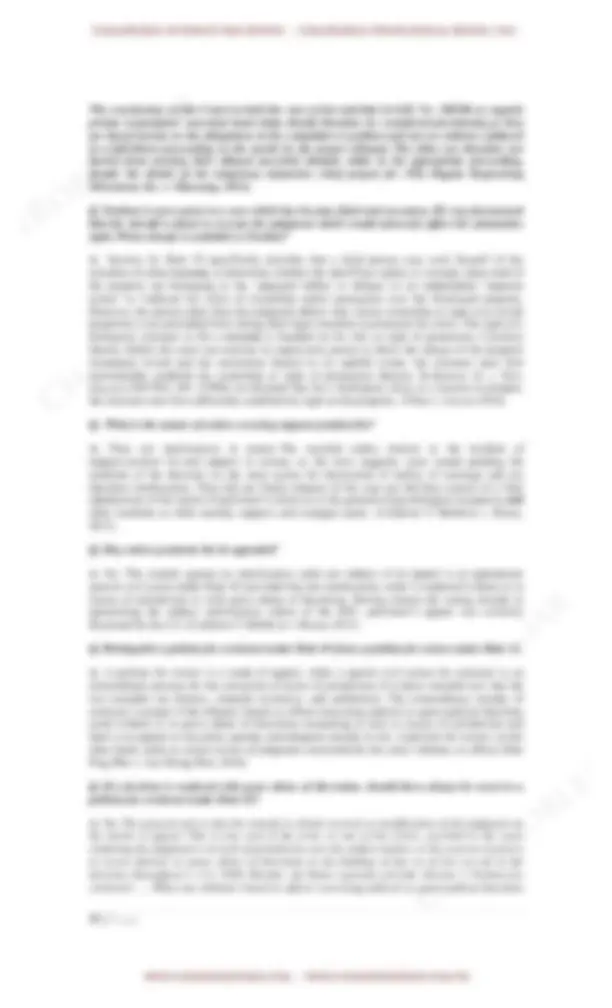

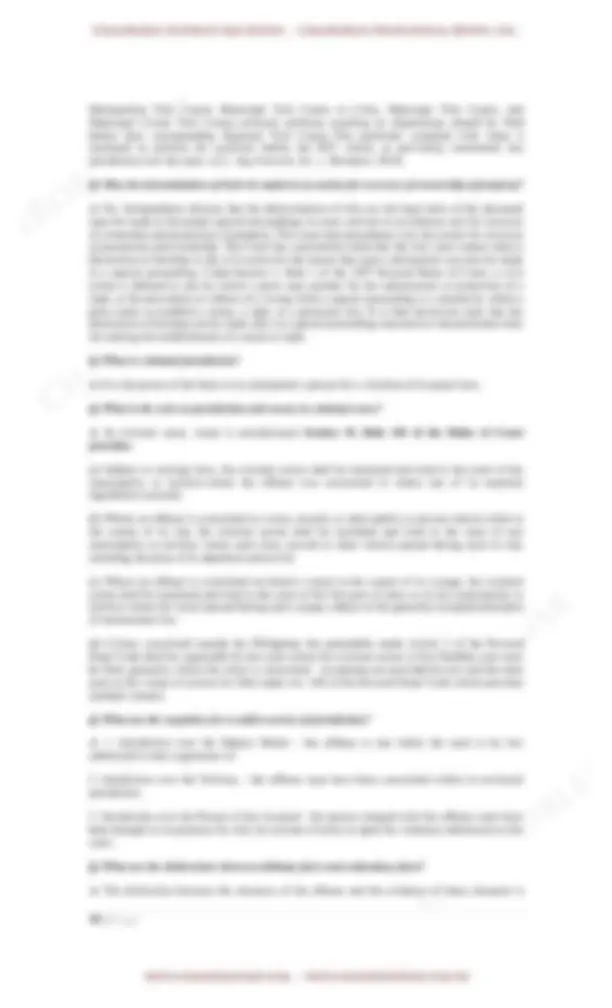
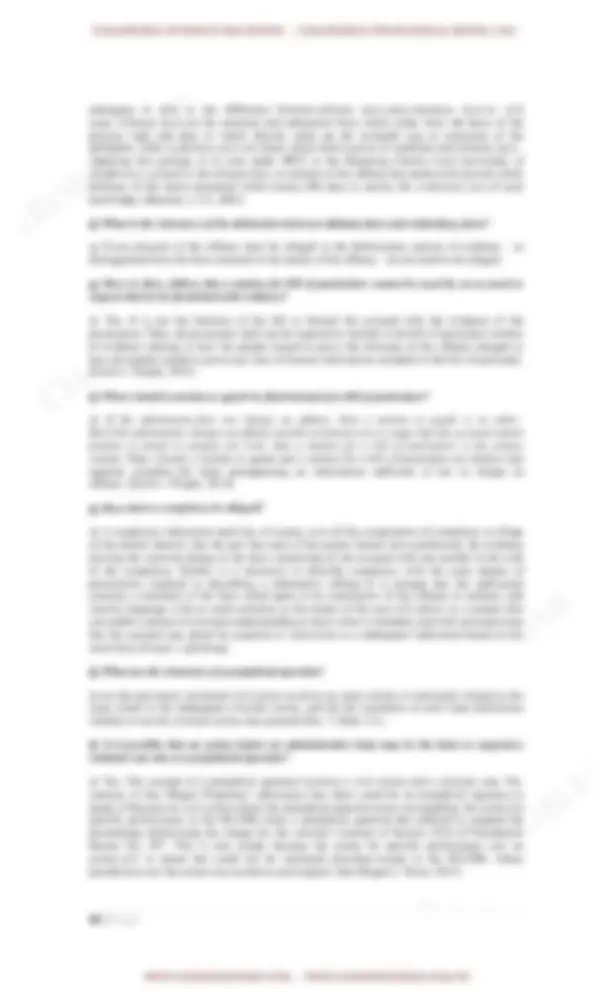
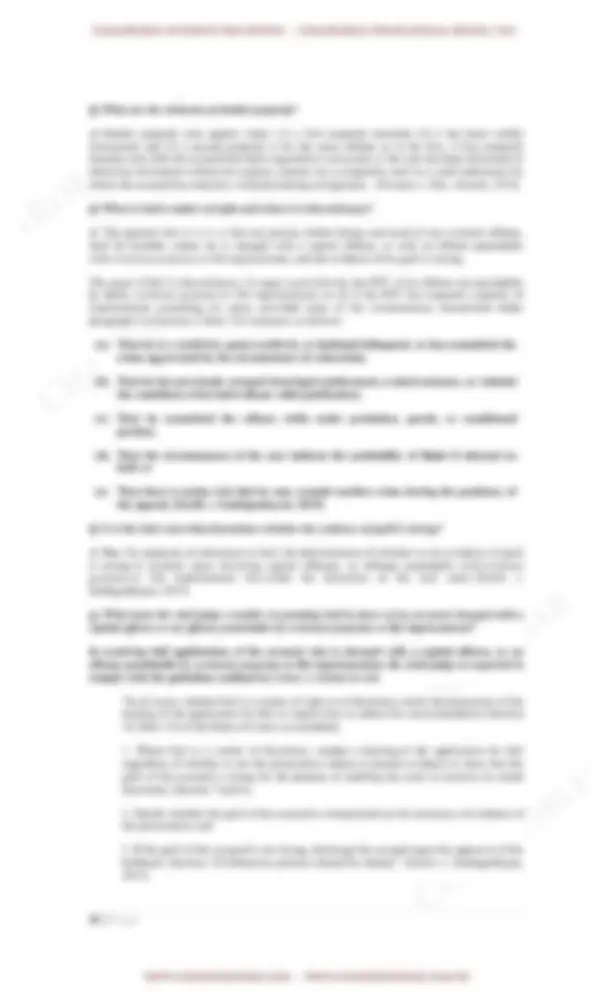
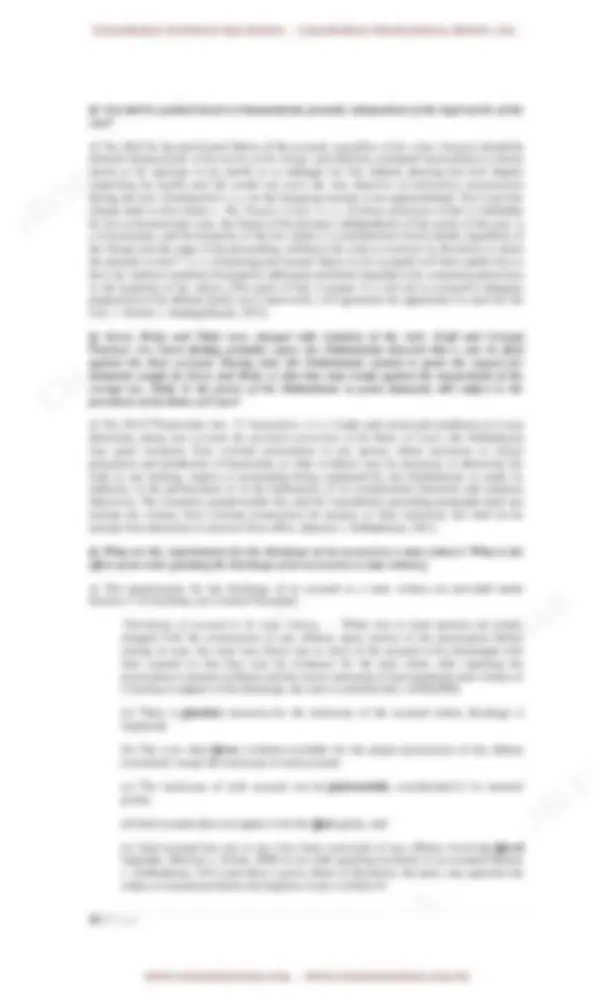
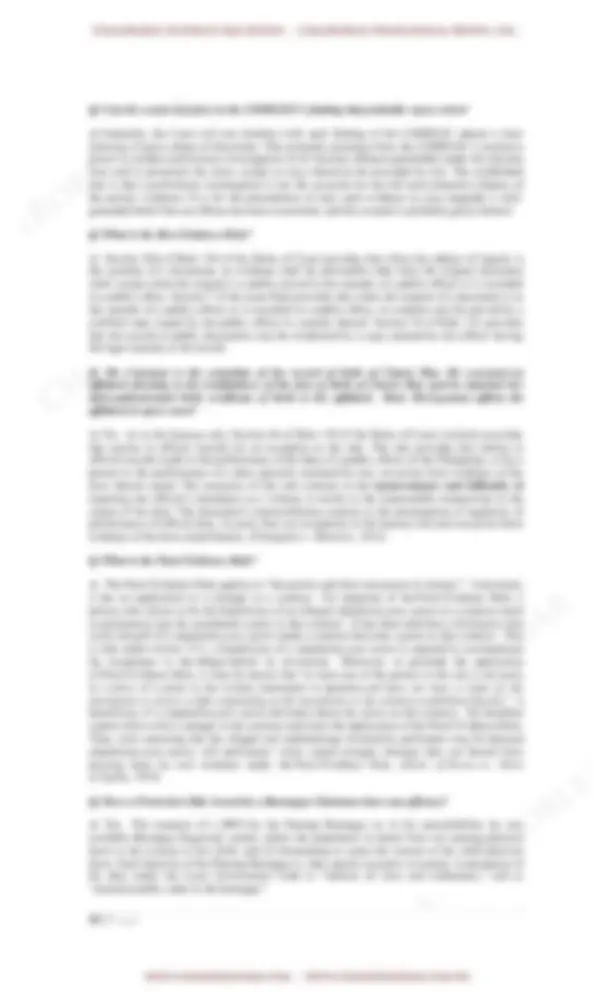
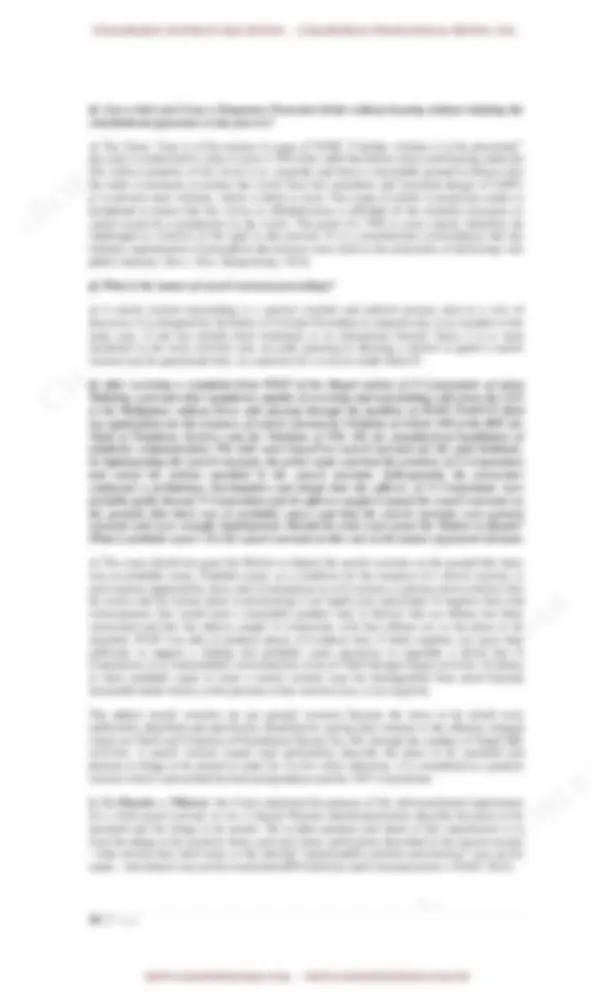
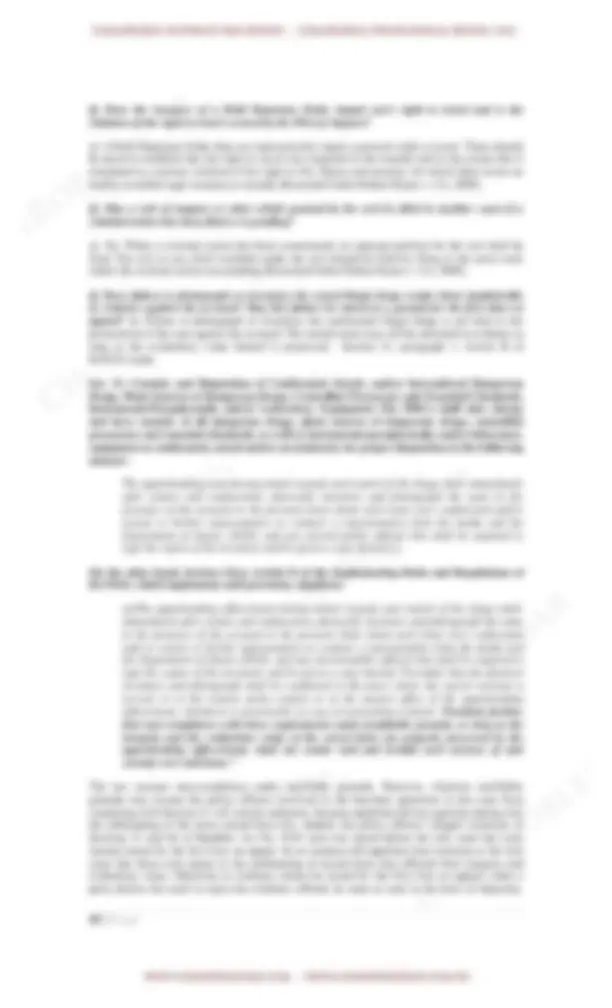



Study with the several resources on Docsity

Earn points by helping other students or get them with a premium plan


Prepare for your exams
Study with the several resources on Docsity

Earn points to download
Earn points by helping other students or get them with a premium plan
Community
Ask the community for help and clear up your study doubts
Discover the best universities in your country according to Docsity users
Free resources
Download our free guides on studying techniques, anxiety management strategies, and thesis advice from Docsity tutors
reviewer on for bar examination in remedial law
Typology: Lecture notes
1 / 46

This page cannot be seen from the preview
Don't miss anything!







































1 | P a g e
Pointers in Remedial Law 2016 BAR EXAMS
By :
PART I: The Velasco Cases
PRINCIPLE OF JUDICIAL HIERARCHY (Mendoza et al., v. Villas, et al)
Question: X filed a Petition with the Supreme Court but failed to cite the particular rule upon which the petition was based. What are the corresponding effects if the petition will be treated as one filed under Rule 65 or one filed under Rule 45?
Answer: If the petition is to be treated as a petition filed under Rule 65 of the Rules of Court, the petition must be dismissed outright for having been filed prematurely. The principle of hierarchy of courts should be applied. Verily, a direct invocation of the Supreme Court’s original jurisdiction to issue these writs should be allowed only when there are special and important reasons therefore, clearly and specifically set out in the petition. On the other hand, direct recourse to this Court has been allowed for petitions filed under Rule 45 when only questions of law are raised. Thus, the Court ruled in Barcenas v. Tomas that Section 1 of Rule 45 clearly states that the following may be appealed to the Supreme Court through a petition for review by certiorari: 1) judgments; 2) final orders; or 3) resolutions of the Court of Appeals, the Sandiganbayan, the Regional Trial Court or similar courts, whenever authorized by law. The appeal must involve only questions of law, not of fact. In this case, the Court exercised liberality and considered the instant petition as one filed under Rule 45. In Artistica Ceramica, Inc. v. Ciudad Del Carmen Homeowners Association, Inc ., citing Republic v. Court of Appeals , the Court noted that with the liberal spirit pervading the Rules of Court and in the interest of justice, it has the discretion to treat a petition for certiorari as having been filed under Rule 45, especially if filed within the reglementary period for filing a petition for review.
DOCTRINE OF NON-INTERFERENCE OR DOCTRINE OF JUDICIAL STABILITY (Rombe Eximtrade vs. Spouses Peralta)
Question: X Corporation filed a Petition for the Declaration of a State of Suspension of Payments with Approval of Proposed Rehabilitation Plan with the RTC (RTC A) which then issued a stay order in X Corporation's favor. Thereafter, RTC A dismissed the petition for rehabilitation of X Corporation because of misrepresentations about its financial status in its petition. On the other hand, respondent Z Corporation initiated a foreclosure proceeding against X Corporation's properties. However, Z Corporation was prevented by the issuance of TRO and injunction issued by another RTC (RTC B) filed by X Corporation Did RTC B interfere with the jurisdiction of RTC A in issuing the TRO and injunction?
Answer: No. The rehabilitation case is distinct and dissimilar from the annulment of foreclosure case, in that the first case is a special proceeding while the second is a civil action. xxx Indeed, the two cases are different with respect to their nature, purpose, and the reliefs sought such that the injunctive writ issued in the annulment of foreclosure case did not interfere with the rehabilitation case. The purpose of the rehabilitation case and the reliefs prayed for by Rombe are the suspension of payments because it "foresees the impossibility of meeting its debts when they respectively fall due," and the approval of its proposed rehabilitation plan. The objective and the reliefs sought by Rombe in the annulment of foreclosure case are, among others, to annul the unilateral increase in the interest rate and to cancel the auction of the mortgaged properties.
MEANING OF JURISDICTION OVER THE SUBJECT MATTER (Cojuangco, Jr. v. Republic)
Question: May subject matter jurisdiction be conferred by the acquiescence of the parties?
Answer: No. Jurisdiction over a subject matter is conferred by law, not by the consent or acquiescence of any or all of the parties. In turn, the issue on whether a suit comes within the
2 | P a g e
penumbra of a statutory conferment is determined by the allegations in the complaint, regardless of whether or not the suitor will be entitled to recover upon all or part of the claims asserted.
JURISDICTION OF AN ADMINISTRATIVE AGENCY (Baltazar vs. Ombudsman)
Question: X was hired by Y to serve as a fishpond watchman over Y's 7-hectare fishpond. However, X's salaries and 10% share in the harvest as agreed upon by them remained unpaid. X then filed with the Provincial Agrarian Reform Adjudication Board (PARAB) a Complaint for Maintenance of Peaceful Possession, Collection of Sum of Money and Supervision of Harvest, alleging that he is an agricultural tenant in possession of the fishpond and is about to be ejected from it. The case was assigned to a Provincial Adjudicator of DARAB. Y contends that the issue does not present an agrarian dispute; that X is not an agricultural tenant as alleged, but is a watchman and therefore, the case is outside the jurisdiction of the Department of Agrarian Reform Adjudication Board (DARAB). Should DARAB take cognizance of the case?
Answer: Yes. Jurisdiction over the subject matter is determined by the allegations of the complaint. The nature of an action is determined by the material averments in the complaint and the character of the relief sought, not by the defenses asserted in the answer or motion to dismiss. Given that X's complaint and its attachment clearly spells out the jurisdictional allegations that he is an agricultural tenant in possession of the fishpond and is about to be ejected from it, clearly, the Provincial Adjudicator could not be faulted in assuming jurisdiction as said allegations characterize an agricultural dispute. Besides, whatever defense asserted in an answer or motion to dismiss is not to be considered in resolving the issue on jurisdiction as it cannot be made dependent upon the allegations of the defendant.
DOCTRINE OF ADHERENCE OF JURISDICTION (People v. Court of Appeals)
Question: X was the accused in a criminal case for violation of Sec. 68 of PD 705 (Cutting, gathering and/or collecting timber or other products without license; Forestry Reform Code), as amended by EO 277 filed before the RTC. The offense is punished with the penalty of prisiόn correccional in its medium and maximum period, if the value of the thing stolen is more than 6,000 pesos but does not exceed 12,000 pesos.”
During the proceedings, Republic Act 7691, a law expanding the jurisdiction of the MTCs to include criminal cases punishable by not more than 6 years of imprisonment, took effect. X was convicted by the RTC. Upon appeal to the CA, the CA granted X's appeal and dismissed the case for lack of jurisdiction of the RTC. Is the CA correct?
Answer: No. As a general rule, the jurisdiction of a court to try a criminal action is to be determined by the law in force at the time of the institution of the action. Where a court has already obtained and is exercising jurisdiction over a controversy, its jurisdiction to proceed to the final determination of the cause is not affected by new legislation placing jurisdiction over such proceedings in another tribunal. The exception to the rule is where the statute expressly provides, or is construed to the effect that it is intended to operate as to actions pending before its enactment. Where a statute changing the jurisdiction of a court has no retroactive effect, it cannot be applied to a case that was pending prior to the enactment of a statute. Where a court acquired jurisdiction over an action, its jurisdiction continues to the final conclusion of the case. Such jurisdiction is not affected by new legislation placing jurisdiction over such dispute in another court or tribunal unless the statute provides for retroactivity.
JURISDICTION OF COURTS (PLEASE READ THIS CAREFULLY)
SUPREME COURT (Star Electric Corp vs. R&G Construction)
Question: In what instances may the Supreme Court resolve not only questions of law but questions of fact as well?
Answer: It is an established rule that in the exercise of its power of review under Rule 45, the Supreme Court only resolves questions of law and not questions of facts. However, this rule is not absolute. Jurisprudence has recognized several exceptions in which factual issues may be resolved by the Supreme Court, such as: (1) when the findings are grounded entirely on speculation, surmises or conjectures; (2) when the inference made is manifestly mistaken, absurd or impossible; (3) when the judgment is based on a misapprehension of facts; (4)
4 | P a g e
Answer: Yes. In determining whether an action is one the subject matter of which is not capable of pecuniary estimation, the Court has adopted the criterion of first ascertaining the nature of the principal action or remedy sought. If it is primarily for the recovery of a sum of money, the claim is considered capable of pecuniary estimation, and whether jurisdiction is in the municipal courts or in the RTCs would depend on the amount of the claim. But where the basic issue is something other than the right to recover a sum of money, where the money claim is purely incidental to, or a consequence of, the principal relief sought, the Court has considered such actions as cases where the subject of the litigation may not be estimated in terms of money, and, hence, are incapable of pecuniary estimation. These cases are cognizable exclusively by RTCs. The instant cause of action to redeem the land is one for specific performance. It is clear that his action is for specific performance, or if not strictly such action, then it is akin or analogous to one of specific performance. Such being the case, his action for specific performance is incapable of pecuniary estimation and cognizable by the RTC. Having fully participated in all stages of the case, and even invoking the RTC’s authority by asking for affirmative reliefs, respondents can no longer assail the jurisdiction of the said trial court. Simply put, considering the extent of their participation in the case, they are, as they should be, considered estopped from raising lack of jurisdiction as a ground for the dismissal of the action.
JURISDICTION OF SHARI'A COURTS IN AN ACTION FOR QUIETING OF TITLE (Tomawis v. Balindong)
Question: Private respondents filed with the Sharia District Court (SDC) an action for quieting of title of a parcel of land against Tomawis who argued that SDC does not have jurisdiction over the case. The respondent judge asserted that SDC has original jurisdiction over the case, concurrently with the RTC by force of Article 143, paragraph 2(b) of Presidential Decree No. (PD) 1083 or the Code of Muslim Personal Laws of the Philippines. Is the judge correct?
Answer: Yes. The allegations, as well as the relief sought by private respondents, the elimination of the cloud of doubts on the title of ownership on the subject land, are within the SDCs jurisdiction to grant. We have held that a general law and a special law on the same subject are statutes in pari materia and should be read together and harmonized, if possible, with a view to giving effect to both. In the instant case, we apply the principle generalia specialibus non derogant. A general law does not nullify a special law. The general law will yield to the special law in the specific and particular subject embraced in the latter. BP 129 and PD 1083 must be construed together, then by taking PD 1083 as an exception to the general law to reconcile the two laws. Moreover , the jurisdiction of the court below cannot be made to depend upon defenses set up in the answer, in a motion to dismiss, or in a motion for reconsideration, but only upon the allegations of the complaint
CIVIL PROCEDURE
CAUSE OF ACTION; MEANING OF CAUSE OF ACTION (St. Michael School v. Masaito Development Corp) (Please read carefully)
Question: What are the requirements to establish a cause of action in an easement complaint under Article 649 (Easement of Right of Way) of the Civil Code?
Answer: For a complaint to state a cause of action in an easement case, more specifically, Art. 649 of the Civil Code has laid down the following requirements: (1) the dominant estate is surrounded by other immovables and has no adequate outlet to a public highway; (2) there is payment of proper indemnity; and (3) the isolation is not due to the acts of the proprietor of the dominant estate. The Complaint, first , asserts that petitioners have a right to an easement of right-of-way that cuts across respondents’ property; second , it refers to respondents’ correlative obligation not to fence off and close the single gate which is used as the only entry and exit points of the school population; and third , it refers to respondents’ expansion and excessive terms and conditions, constituting the acts violating petitioners’ right. Hence, the Complaint’s material allegations are enough to entitle petitioners to a favorable judgment if these are assumed to be true.
FAILURE TO STATE A CAUSE OF ACTION (Vitangcol v. New Vista Properties)
Question: Is a lack of cause of action a ground for dismissal under Rule 16?
5 | P a g e
Answer: No. Lack of cause of action is not a ground for a dismissal of the complaint through a motion to dismiss under Rule 16 of the Rules of Court, for the determination of a lack of cause of action can only be made during and/or after trial. What is dismissible via that mode is failure of the complaint to state a cause of action. The rule is that in a motion to dismiss, a defendant hypothetically admits the truth of the material allegations of the ultimate facts contained in the plaintiff’s complaint. When a motion to dismiss is grounded on the failure to state a cause of action, a ruling thereon should, as rule, be based only on the facts alleged in the complaint.
DEFINITION OF CAUSE OF ACTION (Basic information that you need to remember.) (BF Corp v. MIAA)
Question: X Corporation, Y Corporation and two other corporations formed the MTOB Consortium, a distinct corporation, for purposes of bidding for the construction of the NAIA II Project. The Manila International Airport Authority (MIAA) awarded the contract to MTOB Consortium. Later, the members of MTOB had serious business differences. X Corporation filed a complaint against the other corporations to receive what it alleged to be its share in the project. X Corporation likewise filed a complaint against MIAA to enjoin it from directly paying Y corp. Does X Corporation have a cause of action against MIAA?
Answer: None. A cause of action is defined as an act or omission by which a party violates a right of another. It has three elements: (1) a right existing in favor of the plaintiff, (2) a duty on the part of the defendant to respect the right of the plaintiff, and (3) a breach of the defendant’s duty. BF Corp has no right of action against MIAA for the following reasons:
(1) There is no contractual relation between MIAA and BF Corp. The agreement over the NAIA Terminal II Project was between MIAA and MTOB Consortium, as the contractor. From the start, MIAA recognized MTOB Consortium as a corporation with a distinct personality from its component corporations.
(2) The reliefs prayed for by BF Corp. are based on the consortium agreement, which is a contract among BF Corp. and the other members of the consortium. MIAA is not privy of, and is therefore a stranger to the consortium agreement. If BF Corp. wants its share in the consortium, its recourse is against MTOB Consortium, not MIAA.
PARTIES TO CIVIL ACTIONS: LEGAL STANDING AND CAPACITY TO SUE (Samahang Magsasaka v. Mosquera)
Question: An association of farmer-beneficiaries filed a case against Z alleging that the land they tilled was sold to Z without a DAR clearance, in violation of Section 6-D of CARL. Z applied for exemption from the coverage of CARL alleging that the property is above 18% slope and unfit for cultivation. The Executive Secretary exempted the property from CARL coverage. The case subsequently reached the CA where it ruled that the association is not a real party-in- interest and has no legal standing to sue; that it is not an actual grantee of the land but mere qualified beneficiary. Is the CA correct?
Answer: Yes. According to Sec. 2 of Rule 3 of the Rules of Court, a real party-in-interest is the party who stands to be benefited or injured by the judgment in the suit or the party entitled to the reliefs of the suit. The Supreme Court stood by its ruling in Fortich v. Corona that farmer-beneficiaries, who are not approved awardees of CARP, are not real parties-in-interest for being mere recommendees. In the case at bar, members of petitioner Samahan are mere qualified beneficiaries of CARP but they have not yet been approved as awardees, actually awarded lands, or granted CLOAs.
JURISDICTION OF CIAC IN ARBITRATION PROCEEDINGS – LEGAL STANDING OF A TRANSFEREE PENDENTE LITE (Please read carefully) (Heritage Park Management v. CIAC)
Question: Public Estates Authority (PEA) was designated to develop the Heritage Park in Taguig. PEA entered into an agreement with X where X undertook to perform all landscaping works on the Heritage Park. Due to delays, the contract period was extended and among the causes of delay was PEA’s inability to deliver to X some 45 hectares of the property due to the presence of squatters and a public cemetery. X filed a Complaint with the CIAC seeking to
7 | P a g e
respective claim. Second , adjudication in favor of one will necessarily bar the other since these two actions are absolutely incompatible with each other; a debt cannot be fully paid and partially unpaid at the same time. Third , these two opposing claims arose from the same set of transactions. And finally , if these two claims were to be the subject of separate trials, it would definitely entail a substantial and needless duplication of effort and time by the parties and the court, for said actions would involve the same parties, the same transaction, and the same evidence.
RES JUDICATA (Clark Development v. Mondragon)
Question: What are the requisites of res judicata?
Answer: Res judicata means a matter or thing adjudged, judicially acted upon or decided, or settled by judgment. Its requisites are: (1) the former judgment or order must be final; (2) the judgment or order must be one on the merits; (3) it must have been rendered by a court having jurisdiction over the subject matter and parties; and (4) between the first and second actions, there must be identity of parties, subject matter, and causes of action.
FORUM SHOPPING (Cuenca v. Atas)
Question: X was the incorporator and President of ABC Corporation which was granted a franchise to construct the toll facilities of North Luzon/South Luzon Expressways. In the course of its operations, ABC incurred credit obligations from various Government Financial Institutions (GFIs). Then President Marcos issued a Letter of Instruction directing the creditor GFIs to convert into ABCs shares of stock. X filed with the Securities and Exchange Commission (SEC) a case to determine whether the GFIs are stockholders of ABC Corporation and their respective number of shares. X likewise filed a civil case for the enforcement and compliance of the said Letter of Instruction. Did X commit forum shopping?
Answer: Yes. There is forum shopping "when a party repetitively avails of several judicial remedies in different courts, simultaneously or successively, all substantially founded on the same transactions and the same essential facts and circumstances, and all raising substantially the same issues either pending in or already resolved adversely by some other court." Forum shopping is an act of malpractice that is prohibited and condemned because it trifles with the courts and abuses their processes. It degrades the administration of justice and adds to the already congested court dockets. A close perusal of both the Amended Complaint in SEC and the Amended Complaint in Civil Case shows that both cases are derived from the same factual issues involving substantially the same parties. Although the actions seem to be different, yet it can be seen that there is a splitting of a cause of action.
VERIFICATION AND CERTIFICATION AGAINST FORUM SHOPPING (Cagayan Valley Drug Corp. v. CIR)
Question: Which officials and employees of a company may validly sign the Verification and Certification of Non-Forum Shopping even without a board resolution?
Answer: The following officials or employees of the company can sign the verification and certification without need of a board resolution: (1) the Chairperson of the Board of Directors, (2) the President of a corporation, (3) the General Manager or Acting General Manager, (4) Personnel Officer, and (5) an Employment Specialist in a labor case. This complies with Sections 4 and 5, Rule 7 of the 1997 Revised Rules on Civil Procedure
The rationale applied in the foregoing is to justify the authority of corporate officers or representatives of the corporation to sign the verification or certificate against forum shopping, being "in a position to verify the truthfulness and correctness of the allegations in the petition.”
LITIS PENDENCIA (Subic Telecom v. SBMA)
Question: What factors will indicate that there exists litis pendencia?
Answer: For litis pendentia to exist, the following requisites or elements must concur: (a) identity of parties, or at least such parties who represent the same interests in both actions; (b) identity of rights asserted and relief prayed for, the relief being founded on the same facts; and (c) identity with respect to the two (2) preceding particulars in the two (2) cases is such that any
8 | P a g e
judgment that may be rendered in the pending case, regardless of which party is successful, would amount to res judicata in the other case
ELEMENTS OF LITIS PENDENCIA ( Forbes Park Assoc v. Pagrel, Inc.)
Question: What are the elements of litis pendentia?
Answer: The essential elements of litis pendentia are as follows: (1) identity of parties or representation in both cases; (2) identity of rights asserted and reliefs prayed for; (3) reliefs founded on the same facts and the same basis; and (4) identity of the two preceding particulars should be such that any judgment, which may be rendered in the other action, will, regardless of which party is successful, amount to res judicata in the action under consideration.
DENIAL UNDER OATH - ALLEGATIONS IN A PLEADING (Casent Realty v. PhilBanking Corp)
Question: PhilBank was the assignee of two promissory notes issued by X Corporation. Upon due date, X Corporation failed to pay PhilBank which promoted the latter to file a collection case. X corp. answered that the complaint stated no cause of action because the parties executed a Dacion en Pago with the intention of extinguishing X Corporation's obligations, as evidenced by a Confirmation Statement. PhilBank did not file any Reply. X corp. claims that the failure to file a Reply to the Answer which raised the defense of Dacion en Pago constituted an admission of the genuineness and execution of the documents such as the Confirmation Statement. Is X corporation correct?
Answer: Yes. Rule 8, Section 8 specifically applies to actions or defenses founded upon a written instrument and provides the manner of denying it which must be under oath and specifically denies the instrument otherwise its genuineness and due execution shall be admitted. It is more controlling than Rule 6, Section 10 which merely provides the effect of failure to file a Reply which is all the new matters alleged in the Answer were deemed controverted. Thus, where the defense in the Answer is based on an actionable document, a Reply specifically denying it under oath must be made; otherwise, the genuineness and due execution of the document will be deemed admitted
MOTION TO DISMISS, NOT A RESPONSIVE PLEADING (Marcos-Araneta v. Court of Appeals)
Question: Is a Motion to Dismiss a responsive pleading the filing of which will preclude the amendment of the Complaint?
Answer: No. According to Sec. 2 Rule 10 of the Rules of Court, A party may amend his pleading once as a matter of right at any time before a responsive pleading is served. Responsive pleadings are those which seek affirmative relief and/or set up defenses. A motion to dismiss is not a responsive pleading. According the Sec. 2 Rule 4 indicates quite clearly that when there is more than one plaintiff in a personal action case, the residences of the principal parties should be the basis for determining proper venue.
SUMMONS: SUBSTITUTED SERVICE (Garcia v. Sandiganbayan) (PLEASE COMMIT TO MEMORY)
Question: What are the requirements for a valid substituted service of summons?
Answer: The following are the requirements for substituted service of summons to be valid: (1) Impossibility of prompt personal service; (2) Specific details in the return; and (3) Substituted service effected on a person of suitable age and discretion residing at defendant’s house or residence; or on a competent person in charge of defendant’s office or regular place of business.
From the foregoing requisites, it is apparent that no valid substituted service of summons was made on petitioner and her children, as the service made through Maj. Gen. Garcia did not comply with the first two (2) requirements mentioned above for a valid substituted service of summons. Moreover, the third requirement was also not strictly complied with as the substituted service was made not at petitioner’s house or residence but in the PNP Detention Center where
10 | P a g e
RES JUDICATA, INTERPLEADER (Bliss Development v. Diaz)
Question: BDC sold its property to Sps. Melgazo, both of whom are now deceased. Diaz claimed to be the transferee of the said property and traced his right from one Domingo Tapay. Diaz then paid BDC the amortizations due on the property, and BDC issued a permit to occupy the property in favor of Diaz. Diaz then introduced improvements on the property. A contract to sell was later issued in favor of Diaz. Arreza however claims that the heirs of Sps. Melgazo sold to him the rights over the property. To resolve the conflicting claims, BDC filed a complaint for Interpleader. The RTC ruled that Arreza had a better right over the property, which decision became final and executory. Later, Diaz filed a complaint for sum of money against BDC, Arreza and Tapay. Arreza filed a Motion to Dismiss, citing res judicata. Is the complaint barred by res judicata because of the previous decision of the court in the interpleader case?
Answer: No. The essential elements of res judicata are not present. First, the interpleader case was between Arreza and Diaz. While it was BDC that initiated the interpleader case, the opposing parties in that prior case is, in fact, Arreza and Diaz. Second, the issues resolved in the interpleader case revolved around the conflicting claims of Arreza and Diaz, and not whatever claim either of them may have against BDC. Thus, there is no identity of parties, nor identity of subject matter, between the interpleader case and the one at bar.
RES JUDICATA, LABOR CASE (Oriental Ship management v. Bastol)
Question: X, a seaman who was repatriated because of heart disease, won in the Labor Arbiter level on his claim for disability benefits against his employer ABC. The NLRC however remanded the case to the Labor Arbiter for the conduct of clarificatory hearings for a more certain determination of the state of health of X. Later, the Labor Arbiter still ruled in favor of X and granted him disability benefits, but the NLRC on appeal, reversed the decision. X appealed to the CA which reinstated the Labor Arbiter's decision. The employer ABC claims that the decision of the NLRC ordering the remand of the case to the Labor Arbiter has attained finality; hence the CA violated the principle of Res Judicata and the “law of the case.” Is the employer correct?
Answer: No. The doctrine of res judicata is inapplicable. The July 30, 1999 NLRC Decision cannot and does not constitute res judicata to the instant case. Res judicata has two concepts: (a) bar by former judgment and (b) conclusiveness of judgment. These concepts of the doctrine of res judicata are applicable to second actions involving substantially the same parties, the same subject matter, and cause or causes of action. In the instant case, there is no second action to speak of, involving as it is the very same action albeit the NLRC remanded it to the Labor Arbiter for further proceedings.
PRE-TRIAL, NOTICE OF PRE-TRIAL (PNB v. Sps. Perez)
Question: May the judge validly consider or treat an ordinary hearing to be the pre-trial conference between the parties?
Answer: No. Section 3, Rule 18 of the 1997 Rules on Civil Procedure unequivocally requires that the notice of pre-trial shall be served on counsel, or on the party who has no counsel. The notice of pre-trial seeks to notify the parties of the date, time and place of the pre-trial and to require them to file their respective pre-trial briefs within the time prescribed by the rules. Its absence, therefore, renders the pre-trial and all subsequent proceedings null and void.
In the case at bar, the order issued by the trial court merely spoke of a “hearing” and required PNB “to prepare a complete statement of account.” The order does not mention anything about a pre-trial to be conducted by the trial court. The CA aptly held that the Order which declared the haring to be a pre-trial and allowed the Spouses to adduce evidence ex parte, is void. Similarly, its ruling that the Decision and all subsequent orders issued pursuant to said judgment are also null and void, is proper.
LIBERALITY IN APPLICATION OF TECHNICAL RULES, APPEARANCE OF PARTIES; EFFECT OF FAILURE TO APPEAR (Spouses Leyba v. Rural Bank of Cabuyao) (Please take note of this case.)
Question: Sps. A and B filed a complaint for Nullification of Real Estate Mortgage and Special Power of Attorney (SPA) against Rural Bank of Cabuyao, Inc. (RBCI) and Reyes alleging that A
11 | P a g e
was made to sign an SPA, granting Reyes the authority to mortgage a land; that Reyes used the SPA to obtain loan from RBCI guaranteed by a real estate mortgage over the subject land. During the pre-trial, Sps. A and B and their counsel failed to attend. Citing Sec. 5, Rule 18 of the Rules of Court, the RTC dismissed the complaint for lack of interest to prosecute the case. Is the RTC correct?
Answer: No. It is the policy of the Court to afford party-litigants the amplest opportunity to enable them to have their cases justly determined, free from the constraints of technicalities. The Court noted that the subject matter of the complaint is to petitioners a valuable parcel of land measuring 259 square meters. Petitioners stand to lose a lot on account of a mere technicality. They have manifested their interest to pursue the case even on appeal. They also have adequately explained their failure to attend the pre-trial conference. In the interest of substantive justice, we allow the petitioners an opportunity to present their side during a trial on the merits, to obviate jeopardizing substantive justice. This liberality underscores the importance of an appeal in our judicial grievance structure to give party-litigants the amplest opportunity for the just disposition of their cause freed from the noose of technicalities.
ALTERNATIVE DISPUTE RESOLUTION (EPCIB v. RCBC) (Please read this very well)
Question: What is the mode of appeal in assailing the RTC decision that confirmed an arbitral award?
Answer: The proper mode of appeal assailing the decision of the RTC confirming an arbitral award is an appeal before the CA pursuant to Sec. 46 of Republic Act No. (RA) 9285, otherwise known as the Alternative Dispute Resolution Act of 2004 , or completely, An Act to Institutionalize the Use of an Alternative Dispute Resolution System in the Philippines and to Establish the Office for Alternative Dispute Resolution, and for other Purposes , promulgated on April 2, 2004 and became effective on April 28, 2004 after its publication on April 13, 2004.
NATURE OF VOLUNTARY ARBITRATION (Benguet Corp. V. DENR)
Question: Is a stipulation requiring voluntary arbitration before resort is made to the courts or quasi-judicial agencies a valid contractual stipulation?
Answer: Yes. Availment of voluntary arbitration before resort is made to the courts or quasi-judicial agencies of the government is a valid contractual stipulation that must be adhered to by the parties. In other words, in the event a case that should properly be the subject of voluntary arbitration is erroneously filed with the courts or quasi-judicial agencies, on motion of the defendant, the court or quasi-judicial agency shall determine whether such contractual provision for arbitration is sufficient and effective. If in affirmative, the court or quasi-judicial agency shall then order the enforcement of said provision.
EFFECT OF ARBITRATION CLAUSE IN CASE OF CONFLICT (Korea Technologies, Co. V. Lerma)
Question: X entered into a contract with Y whereby the former shall construct a liquefied gas cylinder manufacturing plant. It was stipulated in the contract that in case of conflict between the parties, the parties should first attempt to settle their dispute through arbitration. A conflict erupted between the parties. Y was reminded of the arbitration stipulation in their contract and filed an Application for Arbitration before the Korean Commercial Arbitration Board pursuant to Article 15 of the Contract. X contends that the arbitration stipulation in their contract is null and void for being against public policy as it ousts the local courts of jurisdiction over the instant controversy. Is X correct?
Answer: No. The Court, reiterating its ruling in LM Power Engineering Corporation v. Capitol Industrial Construction Groups, Inc ., held: Being an inexpensive, speedy and amicable method of settling disputes, arbitration along with mediation, conciliation and negotiations encouraged by the Supreme Court. Aside from unclogging judicial dockets, arbitration also hastens the resolution of disputes, especially of the commercial kind. It is thus regarded as the wave of the future in international civil and commercial disputes. Brushing aside a contractual agreement calling for arbitration between the parties would be a step backward. The arbitration clause was mutually and voluntarily agreed upon by the parties. Submission to arbitration is a
13 | P a g e
accomplish the assigned tasks given to the agencies, the Committee recommended that time frames be set for the said purpose. Hence, Resolutions were issued by the SC to implement the Decision. This was viewed as an encroachment on the power and functions of the Executive Branch headed by the President. Did the Court encroach on the power and function of the President?
Answer: No. The issuance of subsequent resolutions by the Court is simply an exercise of judicial power under Art. VIII of the Constitution, because the execution of the Decision is but an integral part of the adjudicative function of the Court. While additional activities are required of the agencies like submission of plans of action, data or status reports, these directives are but part and parcel of the execution stage of a final decision under Rule 39 of the Rules of Court. It is clear that the final judgment includes not only what appears upon its face to have been so adjudged but also those matters actually and necessarily included therein or necessary thereto. With the final and executory judgment in the MMDA case, the writ of continuing mandamus issued means that until petitioner-agencies have shown full compliance with the Courts orders, the Court exercises continuing jurisdiction over them until full execution of the judgment.
IMMUTABILITY OF JUDGMENT (Mocorro v. Ramirez)
Question: Explain the principle of immutability of judgment vis-a-vis a final decision.
Answer: A decision that has acquired finality becomes immutable and unalterable. This quality of immutability precludes the modification of a final judgment, even if the modification is meant to correct erroneous conclusions of fact and law. And this postulate holds true whether the modification is made by the court that rendered it or by the highest court in the land. The orderly administration of justice requires that, at the risk of occasional errors, the judgments/resolutions of a court must reach a point of finality set by the law. The noble purpose is to write finis to dispute once and for all. This is a fundamental principle in our justice system, without which there would be no end to litigations. Utmost respect and adherence to this principle must always be maintained by those who exercise the power of adjudication. Any act, which violates such principle, must immediately be struck down.
FINALITY OF JUDGMENT (Spouses Coloso v. Garilao)
Question: May the DAR Secretary modify a final and executory judgment of the court?
Answer: No. A decision that acquired finality becomes immutable and unalterable and may no longer be modified in any respect even if the modification is meant to correct erroneous conclusions of fact or law and whether it will be made by the court that rendered it or by the highest court of the land.
COMPLETE PARTITION v. PARTIAL PARTITION OF LAND (Monteroso v. Court of Appeals)
Question: X prayed for partial partition of a parcel of land but the court ordered a complete partition thereof with accounting. Is the court's order proper?
Answer: Yes. The Philippine judicial system requires courts to apply the law and grant remedies when appropriately called for by law and justice. In the exercise of this mandate, courts have the discretion to apply equity in the absence or insufficiency of the law. In the instant case, a disposition only ordering partial partition and without accounting, as petitioners presently urge, would be most impractical. Courts have been cautioned against being dogmatic in rendering decisions, it being preferable if they take a complete view of the case and in the process come up with a just and equitable judgment, eschewing rules tending to frustrate rather than promote substantial justice. Verily, courts should always strive to settle the entire controversy in a single proceeding leaving no root or branch to bear the seed of future litigation.
EXCEPTION TO THE RULE ON IMMUTABILITY OF JUDGMENTS (Anastacio Tuballa v. Cabrera, et al.)
Question: What are the exceptions to the rule on immutability of judgments?
14 | P a g e
Answer: As a rule, a decision that has acquired finality becomes immutable and unalterable. A final judgment may no longer be modified in any respect, even if the modification is meant to correct erroneous conclusions of fact and law; and whether it be made by the court that rendered it or by the highest court in the land. The orderly administration of justice requires that the judgments/resolutions of a court or quasi-judicial body must reach a point of finality set by the law, rules, and regulations. The only exceptions to the rule that final judgments may no longer be modified in any respect are (1) the correction of clerical errors, (2) the so-called nunc pro tunc entries which cause no prejudice to any party, and (3) void judgments.
POST JUDGMENT REMEDIES
MOTION FOR NEW TRIAL OR RECONSIDERATION (SM land Inc. v. BCDA)
Question: When may the Supreme Court allow the filing of a second Motion for Reconsideration of its decision?
Answer: The concurrence of the following elements are required for a second motion for reconsideration to be entertained:
a. The motion should satisfactorily explain why granting the same would be in the higher interest of justice;
b. The motion must be made before the ruling sought to be reconsidered attains finality;
c. If the ruling sought to be reconsidered was rendered by the Court through one of its Divisions, at least three (3) members of the said Division should vote to elevate the case to the Court En Banc; and
d. The favorable vote of at least two-thirds of the Court En Banc’s actual membership must be mustered for the second motion for reconsideration to be granted. Unfortunately for respondent- movants, the foregoing requirements do not obtain in the case at bench.
APPEALS IN GENERAL (Silverio, Jr. v. Court of Appeals)
Question: What is the rationale for the rule disallowing appeals from interlocutory orders of the court?
Answer: The rationale behind the rule proscribing the remedy of appeal from an interlocutory order is to prevent undue delay, useless appeals and undue inconvenience to the appealing party by having to assail orders as they are promulgated by the court, when they can be contested in a single appeal. The appropriate remedy is thus for the party to wait for the final judgment or order and assign such interlocutory order as an error of the court on appeal.
PERFECTION OF APPEAL (Batalla v. COMELEC)
Question: X and Y were candidates for the position of Punong Barangay. X was proclaimed the Punong Barangay. Y filed an election protest and claimed that there was a misappreciation of seven ballots. MCTC rendered its Decision finding that X and Y had garnered an equal number of votes. Aggrieved, X timely filed his Notice of Appeal of the decision elevating the election protest before the Comelec. X paid the PhP 1,000 appeal fee to the trial court within the five-day period from receipt of the decision and the additional PhP 3,200 appeal fee to the Comelec Cash Division within 15 days from the filing of his notice of appeal. The Comelec First Division dismissed the appeal, and the Comelec En Banc denied his motion for reconsideration for X's failure to pay the appeal fee and because of Verification issues. Is the Comelec correct?
Answer: No. In the instant case, we find that Batalla already perfected his appeal by filing his Notice of Appeal and by paying the PhP 1,000 appeal fee, pursuant to A.M. No. 07-4-15-SC, within the five-day reglementary period, to the MCTC; and by paying the additional appeal fee of PhP 3,200 to the Comelec Cash Division on March 5, 2008..
16 | P a g e
ORDERS OF THE RTC (PNB v. Pasimio)
Question: May the Court of Appeals entertain questions of fact raised in a Rule 41 appeal?
Answer: Yes. Section 9 of Bates Pambansa Blg. (BP) 129, otherwise known as the Judiciary Reorganization Act of 1980, categorically states that the CA has, inter alia, the power to try cases, receive evidence and perform any and all acts necessary to resolve factual issues raised in cases falling within its original and appellate jurisdiction. It is also worthy to note that the appellate court's reliance on the factual findings of the trial court is hinged on the latter's firsthand opportunity to hear the witnesses and to observe their demeanor during the trial. However, when such findings are not anchored on their credibility and their testimonies, but on the assessment of documents that are available to appellate magistrates and subject to their scrutiny, reliance on the trial courts factual findings finds no application.
REVIEW OF FINAL JUDGMENTS OR FINAL ORDERS OF THE OMBUDSMAN (Aguilar v. Hernandez)
Question: What is the remedy to question the Ombudsman's decision in administrative disciplinary cases?
Answer: The nature of the case before the Office of the Ombudsman (OMB) determines the proper remedy available to the aggrieved party and with which court it should be filed. In administrative disciplinary cases, an appeal from the OMB’s decision should be taken to the CA under Rule 43, unless the decision is not appealable owing to the penalty imposed. In the case at bar, the Ombudsman, in the exercise of his administrative disciplinary jurisdiction had, after due investigation, adjudged petitioners guilty of grave misconduct and dishonesty and meted the corresponding penalty. Recourse to the CA via a Rule 43 petition is the proper mode of appeal. Rule 43 governs appeals to the CA from decisions or final orders of quasi-judicial agencies.
EXECUTION, SATISFACTION AND EFFECT OF JUDGMENTS (Dalida v. Sps. Naguit)
Question: Astra Corp. acting through its minority stockholder, Dalida, instituted a derivative suit for accounting/receivership with TRO against Naguit because of Naguit's unauthorized withdrawal of corporate funds. The parties filed a compromise agreement that mandated the dismissal of the derivative suit and criminal complaints. The RTC granted Dalida's Motion for Execution but Naguit filed an Urgent Motion to Recall/Quash Writ of Execution on account of supervening events – Astra’s loss of revenues after the approval of the compromise agreement made it impossible for them to comply. The court stayed the execution. Is the stay of execution proper?
Answer: No. The court may stay immediate execution of a judgment where supervening events bring about a material change in the situation of the parties which makes the execution inequitable, or where there is no compelling urgency for the execution because it is not justified by the prevailing circumstances. However, the reason put forward by respondents is insufficient to merit a stay of execution. Respondent Eliseo Naguit cannot renege on his obligation under the compromise agreement by claiming an inability to pay. It would be an anathema to the orderly administration of justice if such an easy excuse is entertained to abrogate a final decision based on a compromise agreement. Neither is there any supervening event which materially and substantially altered the situation of the parties such that execution would be unjust and inequitable. The compromise agreement has the force of law between the parties unless it is void, there is a vice of consent, or there is forgery, or if the terms are so palpably unconscionable, none of which applies in this case.
DISCRETIONARY EXECUTION NOT ALLOWED IN EXPROPRIATION CASES (Curata v. PPA)
Question: Is execution pending appeal applicable to expropriation proceedings.
Answer: No. Discretionary execution of judgments pending appeal under Sec. 2 (a) of Rule 39 does not apply to eminent domain proceedings. PPA’s monies, facilities and assets are government properties. PPA is a government instrumentality charged with carrying out governmental functions through the management, supervision, control and regulation of major
17 | P a g e
ports of the country. It is an attached agency of the Department of Transportation and Communication pursuant to PD 505. Ergo, they are exempt from execution whether by virtue of a final judgment or pending appeal. Funds of PPA partake of government funds, and such may not be garnished absent an allocation by its Board or by statutory grant. If the PPA funds cannot be garnished and its properties, being government properties, cannot be levied via a writ of execution pursuant to a final judgment, then the trial court likewise cannot grant discretionary execution pending appeal, as it would run afoul of the established jurisprudence that government properties are exempt from execution. What cannot be done directly cannot be done indirectly.
ISSUANCE AND CONTENTS OF A WRIT OF EXECUTION (Parel v. Heirs of Prudencio)
Question: What are the instances when the issuance of a writ of execution may be appealed?
Answer: The following are the instances where a writ of execution may be appealed: 1) the writ of execution varies the judgment; 2) there has been a change in the situation of the parties making execution inequitable or unjust; 3) execution is sought to be enforced against property exempt from execution; 4) it appears that the controversy has never been subject to the judgment of the court; 5) the terms of the judgment are not clear enough and there remains room for interpretation thereof; or 6) it appears that the writ of execution has been improvidently issued, or that it is defective in substance, or is issued against the wrong party, or that the judgment debt has been paid or otherwise satisfied, or the writ was issued without authority.
In these exceptional circumstances, considerations of justice and equity dictate that there be some mode available to the party aggrieved of elevating the question to a higher court. That mode of elevation may be either by appeal (writ of error or certiorari), or by a special civil action of certiorari, prohibition, or mandamus.
EXECUTION OF JUDGMENT, MINISTERIAL DUTY OF SHERIFF (Alconera v. Pallanan)
Question: May the sheriff exercise discretion whether or not to execute the judgment?
Answer: Well-settled is that the sheriff’s duty in the execution of a writ is purely ministerial; he is to execute the order of the court strictly to the letter. He has no discretion whether to execute the judgment or not. there was no legal impediment preventing respondent sheriff from performing his responsibility of enforcing the writ of execution. Since Rafols failed to comply with the requirements under the Rules, Cua Beng who prevailed in the unlawful detainer case is entitled as a matter of right to the immediate execution.
PROVISIONAL REMEDIES
PRELIMINARY ATTACHMENT (Republic v. Estate of Lim)
Question: The Republic filed before the Sandiganbayan a complaint averring that Lim, Sr. and Lim, Jr., acted in unlawful collusion with the Marcoses, and took undue advantage of their relationship with the latter. The Republic then prayed for the reconveyance of all funds and property acquired by them in abuse of power through unjust enrichment. When Lim, Sr. passed away, his estate filed a motion to lift the sequestration over certain real properties. Such motion was opposed by the Republic alleging that the sequestered lots stand as security for the satisfaction of any judgment the Republic may obtain against the estate of Lim, Sr.
The Sandiganbayan then lifted the sequestration order. The estate of Lim, Sr. then filed a demurrer to evidence alleging that the Republic’s evidence did not prove or disprove that the defendants on their own or in concert with the Marcoses, amassed ill-gotten wealth. The Republic also filed a Motion for the Issuance of a Writ of Preliminary Attachment against respondents in the amount of its claims, to counter the effects to the lifting of the sequestration order. However, the Sandiganbayan, stating that bare allegations of the commission of fraud by respondents in incurring the obligations are not sufficient for the granting of the writ of preliminary attachment, denied the motion. Is the Sandiganbayan correct?
Answer: No. For a writ of attachment to issue under Sec.1 (d), Rule 57 of the Rules of Court, the applicant must sufficiently show the factual circumstances of the alleged fraud
19 | P a g e
Answer: In order that an injunctive relief may be issued, the applicant must show that: (1) the right of the complainant is clear and unmistakable; (2) the invasion of the right sought to be protected is material and substantial; and (3) there is an urgent and paramount necessity for the writ to prevent serious damage. All of these elements must concur and the absence of even one of them would be fatal in petitioners’ application for the writ.
ISSUANCE OF WRIT OF PRELIMINARY INJUNCTION OVER ADMINISTRATIVE ORDER OF THE BANGKO SENTRAL NG PILIPINAS (BSP v. Antonio-Valenzuela)
Question: The Supervision and Examination Department (SED) of the Bangko Sentral ng Pilipinas (BSP) conducted examinations of the books of the respondent banks. Thereafter, SED sent separate letters to the Board of Directors of each bank, informing them that the SED found that the banks failed to carry out the required remedial measures. The banks noted none of them had received the Report of Examination (ROE) which finalizes the audit findings. Thus, the respondent banks filed a complaint for nullification of the BSP ROE with application for a TRO and writ of preliminary injunction before the RTC. The RTC ruled that the banks were entitled to the writs of preliminary injunction prayed for, holding that the banks are entitled to copies of the ROEs. Is the RTC correct?
Answer: No. The requisites for preliminary injunctive relief are: (a) the invasion of right sought to be protected is material and substantial; (b) the right of the complainant is clear and unmistakable; and (c) there is an urgent and paramount necessity for the writ to prevent serious damage. The issuance by the RTC of writs of preliminary injunction is an unwarranted interference with the powers of the Monetary Board. The actions of the Monetary Board under Sections 29 and 30 of RA 7653 may not be restrained or set aside by the court except on petition for certiorari on the ground that the action taken was in excess of jurisdiction or with such grave abuse of discretion as to amount to lack or excess of jurisdiction.
MANDATORY INJUNCTION (PLRA v. Court of Appeals)
Question: Should the court grant a preliminary prohibitory or mandatory injunction if it will result in a premature resolution of the case, or will grant the principal objective of the parties before merits can be passed upon?
Answer: No. Sec. 3, Rule 58 of the 1997 Revised Rules of Civil Procedure provides that the issuance of a writ of preliminary injunction may be granted provided that 1) the applicant must have a clear and unmistakable right, that is a right in esse ; 2) there is a material and substantial invasion of such right; and 3) there is an urgent need for the writ to prevent irreparable injury to the applicant; and no other ordinary, speedy, and adequate remedy exists to prevent the infliction of irreparable injury.
The purpose of the ancillary relief is to keep things as they peaceably are while the court passes upon the merits. Where a preliminary prohibitory or mandatory injunction will result in a premature resolution of the case, or will grant the principal objective of the parties before merits can be passed upon, the prayer for the relief should be properly denied.
RECEIVERSHIP, APPOINTMENT OF RECEIVER (Vivares v. Reyes)
Question: S was the father of J and T. J and T had an oral partition of the properties left by their father. Upon T's death and believing that T did not receive his full share in the estate of S, his executor and remaining heir, (petitioners) filed for Partition and Recovery of Real Estate. Petitioners later filed a Motion to Place Properties in Litigation under Receivership alleging that to their prejudice, J had, without prior court approval, sold to third parties and transferred in his own name several common properties. J filed his Opposition denying that he had fraudulently transferred any property of the estate of S and asserting that any transfer in his name of said properties was a result of the oral partition between him and T that enabled the latter as well to transfer several common properties in his own name. The court appointed a receiver. Is the court correct?
Answer: No. The power to appoint a receiver is a delicate one and should be exercised with extreme caution and only under circumstances requiring summary relief or where the court is satisfied that there is imminent danger of loss, lest the injury thereby caused be far greater than the injury sought to be averted. The court should consider the consequences to
20 | P a g e
all of the parties and the power should not be exercised when it is likely to produce irreparable injustice or injury to private rights or the facts demonstrate that the appointment will injure the interests of others whose rights are entitled to as much consideration from the court as those of the complainant. In Descallar v. Court of Appeals, we ruled that the appointment of a receiver is not proper where the rights of the parties, one of whom is in possession of the property, are still to be determined by the trial court.
SPECIAL CIVIL ACTIONS
REVIEW OF JUDGMENTS AND FINAL ORDERS OR RESOLUTION OF COMELEC AND COA; APPLICATION OF RULE 65 UNDER RULE 64 (Querubin v. COMELEC)
Question: Are Orders issued by the COMELEC in the exercise of its administrative functions covered by Rule 64?
Answer: No. The Court has consistently held that the phrase "decision, order, or ruling" of constitutional commissions, the COMELEC included, that may be brought directly to the Supreme Court on certiorari is not all-encompassing, and that it only relates to those rendered in the commissions' exercise of adjudicatory or quasi-judicial powers. In the case of the COMELEC, this would limit the provision's coverage to the decisions, orders, or rulings issued pursuant to its authority to be the sole judge of generally all controversies and contests relating to the elections, returns, and qualifications of elective offices. Consequently, Rule 64, which complemented the procedural requirement under Article IX-A, Section 7, should likewise be read in the same sense—that of excluding from its coverage decisions, rulings, and orders rendered by the COMELEC in the exercise of its administrative functions.
CERTIORARI, PROHIBITION AND MANDAMUS (Francisco Motors v. Court of Appeals)
Question: What are the exceptions to the rule that errors not relating to jurisdiction nor involving grave abuse of discretion shall not be decided upon by the court in a Petition for Certiorari?
Answer: The Court has consistently held that where the error sought to be corrected neither relates to the court’s jurisdiction nor involves grave abuse of discretion, review of the error through certiorari will not be allowed. This rule, however, admits exceptions such as (1) when it is necessary to prevent irreparable damages and injury to a party, (2) where the trial judge capriciously and whimsically exercised his judgment, (3) where there may be danger of failure of justice, (4) where an appeal would be slow, inadequate, and insufficient, (5) where the issue raised is one purely of law, (6) where public interest is involved, and (7) in case of urgency.
GRAVE ABUSE OF DISCRETION (Parma, Jr. v. Office of the Deputy Ombudsman)
Question: Several complaints were filed against councillor X before the Office of the Ombudsman: First was a complaint-affidavit for falsification of official documents, second was a complaint-affidavit for alleged violation of the Anti-Graft and Corrupt Practices Act, third was another complaint for falsification of official document and a fourth, for the same crime and offense charged in the first and second complaint. X, however, failed to file a counter-affidavit. The OMB issued a resolution finding probable cause for Falsification of Official Document and recommended the filing of information for said crime against X. The OMB later dismissed the second and third complaints. X accused the OMB of committing grave abuse of discretion against the OMB in recommending the filing of information for Falsification of Official Document despite the OMB's dismissal of the other complaints filed. Did the OMB's act amount to grave abuse of discretion?
Answer: No. G rave abuse of discretion implies such capricious and whimsical exercise of judgment as is equivalent to lack of jurisdiction. It is well-settled that an act of a court or tribunal may only be considered to have been done in grave abuse of discretion when the act was performed in a capricious or whimsical exercise of judgment which is equivalent to lack of jurisdiction. In this case, the imputation of grave abuse of discretion on the part of the Ombudsman cannot be sustained in the instant case because, Parma veritably latches his case on the lame argument that had the Ombudsman duly considered its findings on the second and third